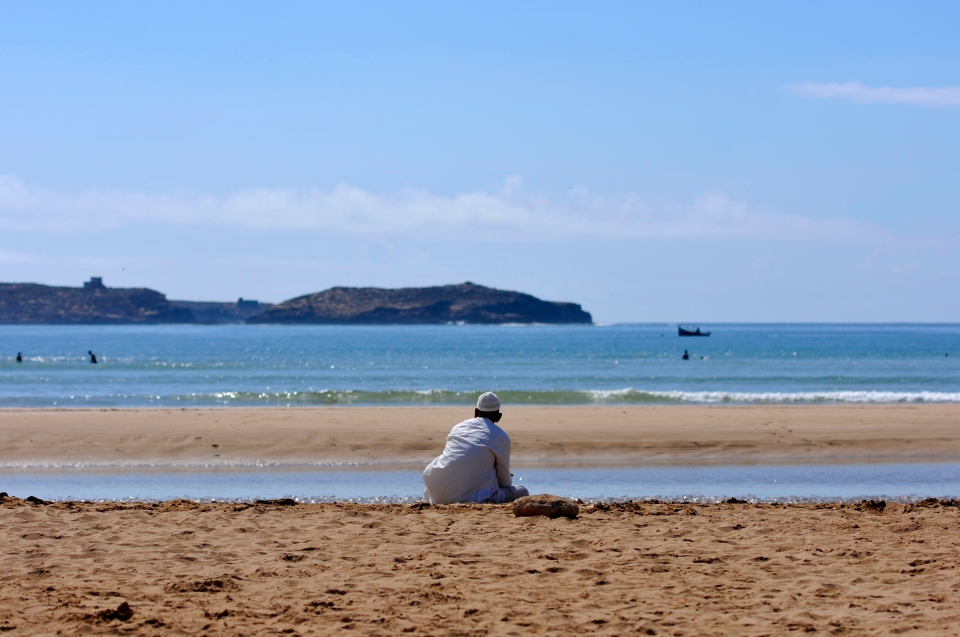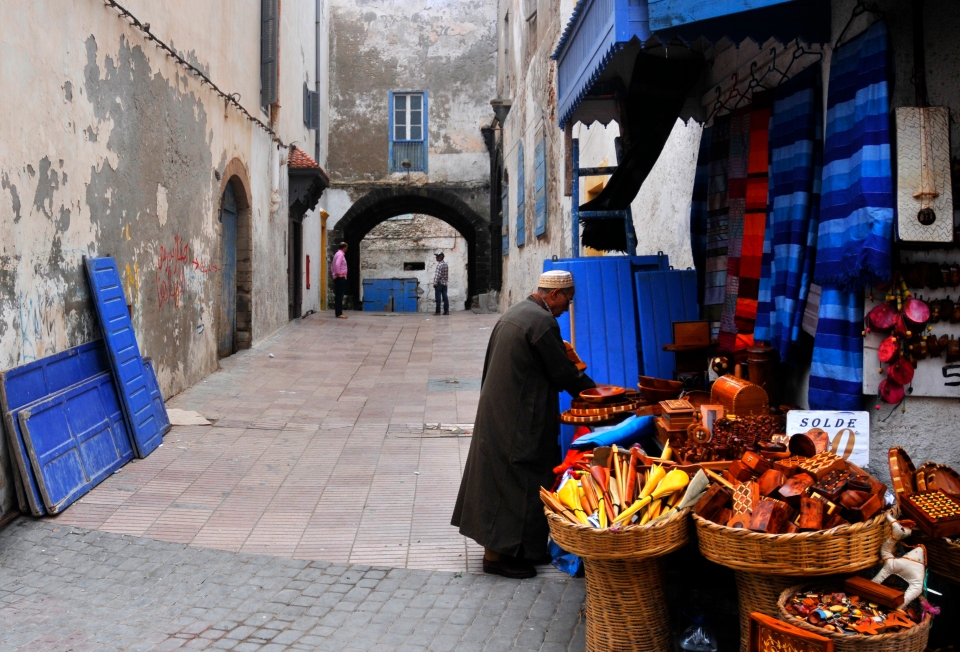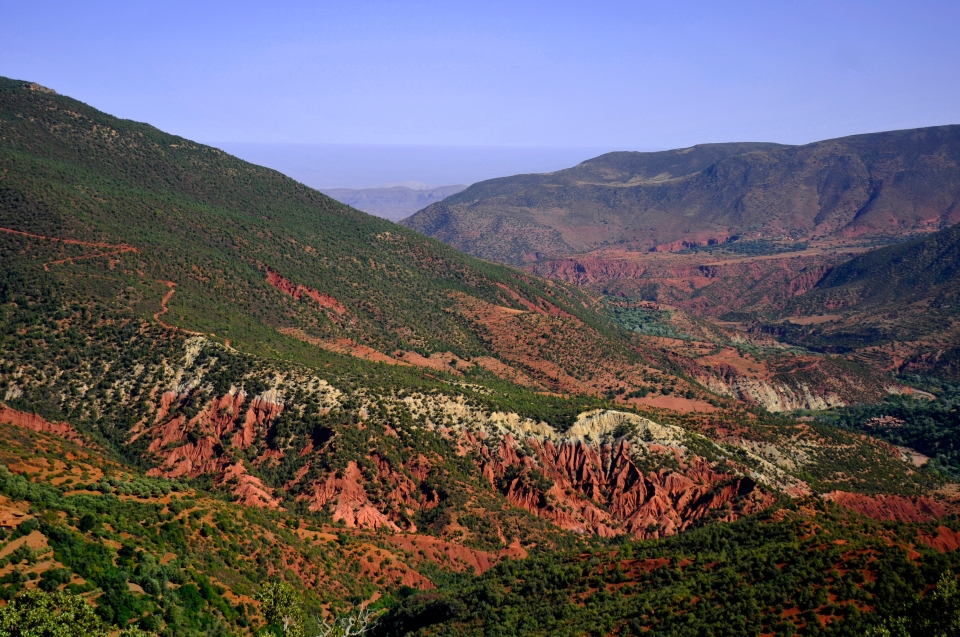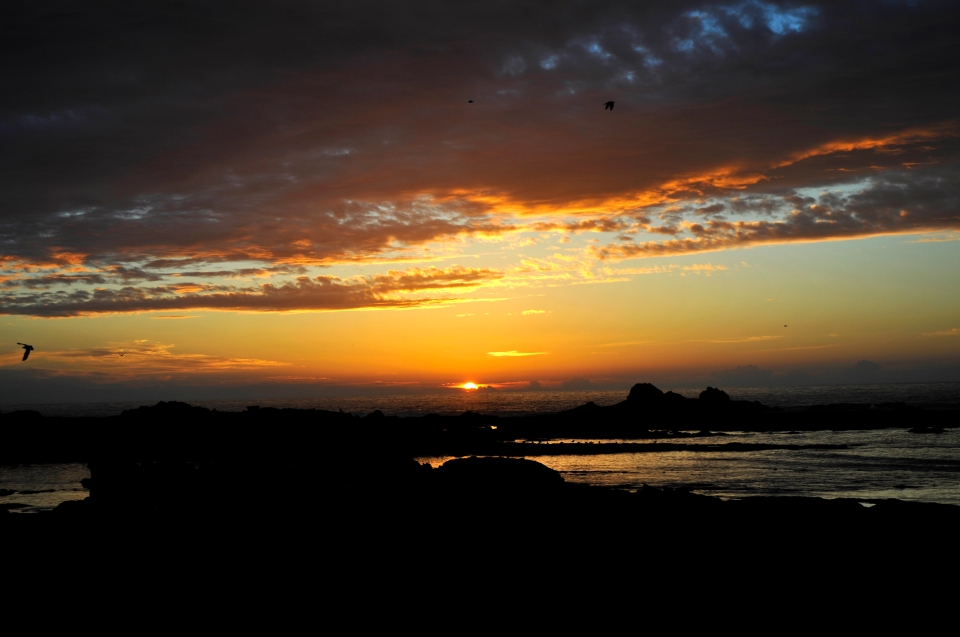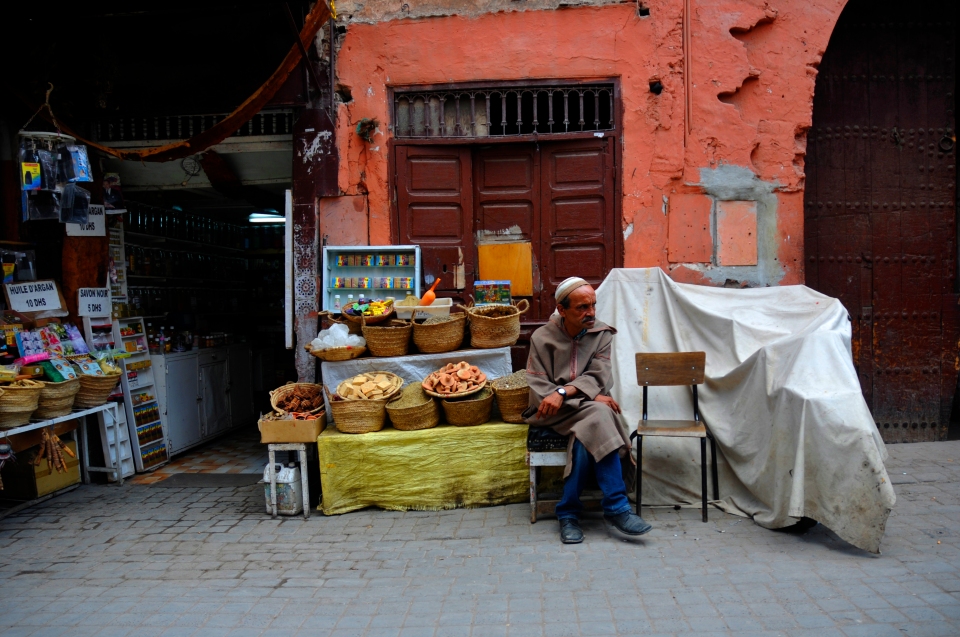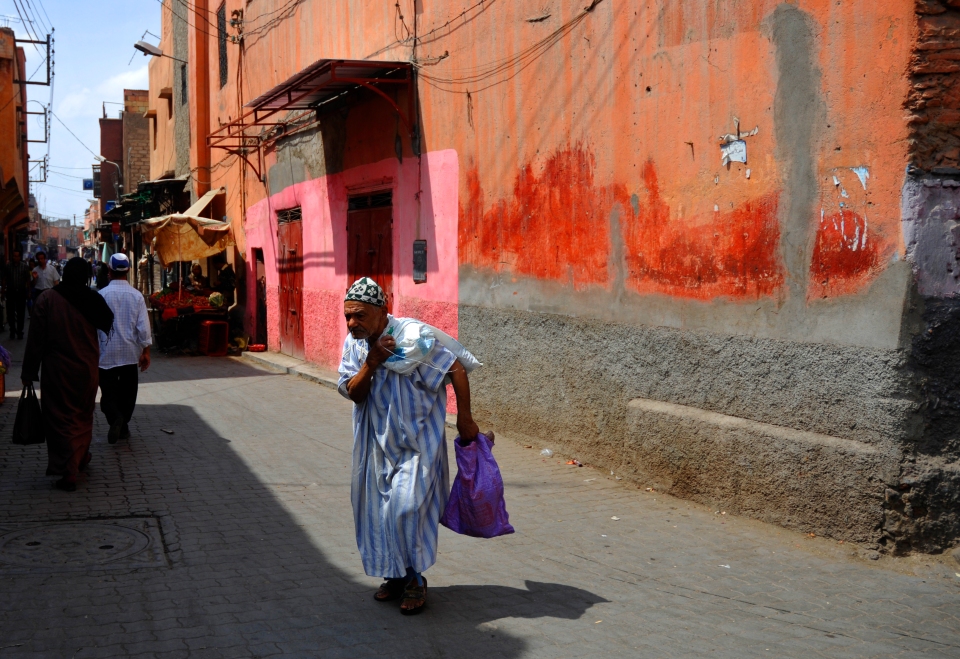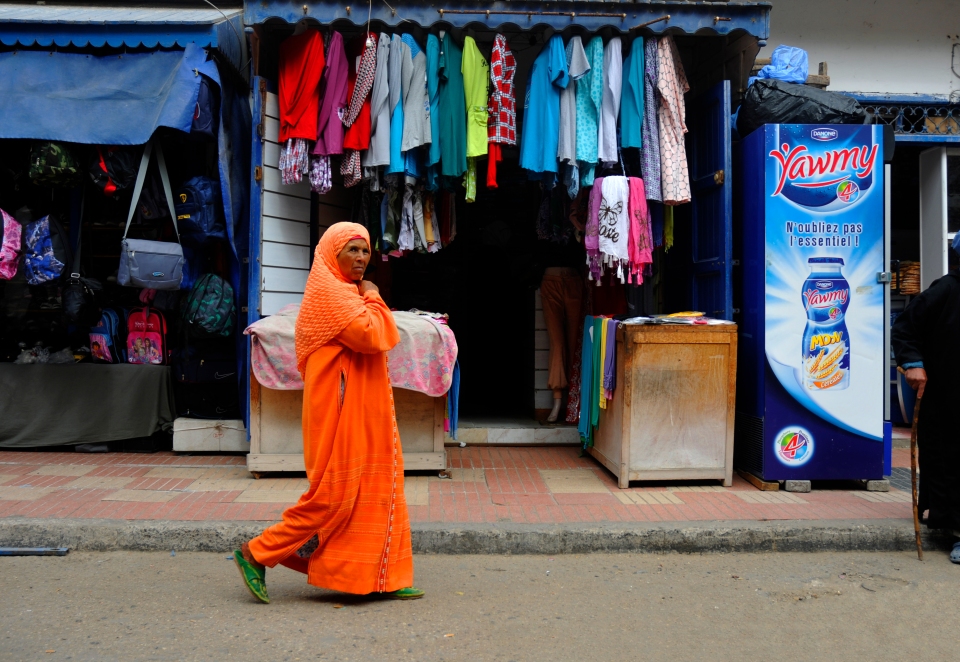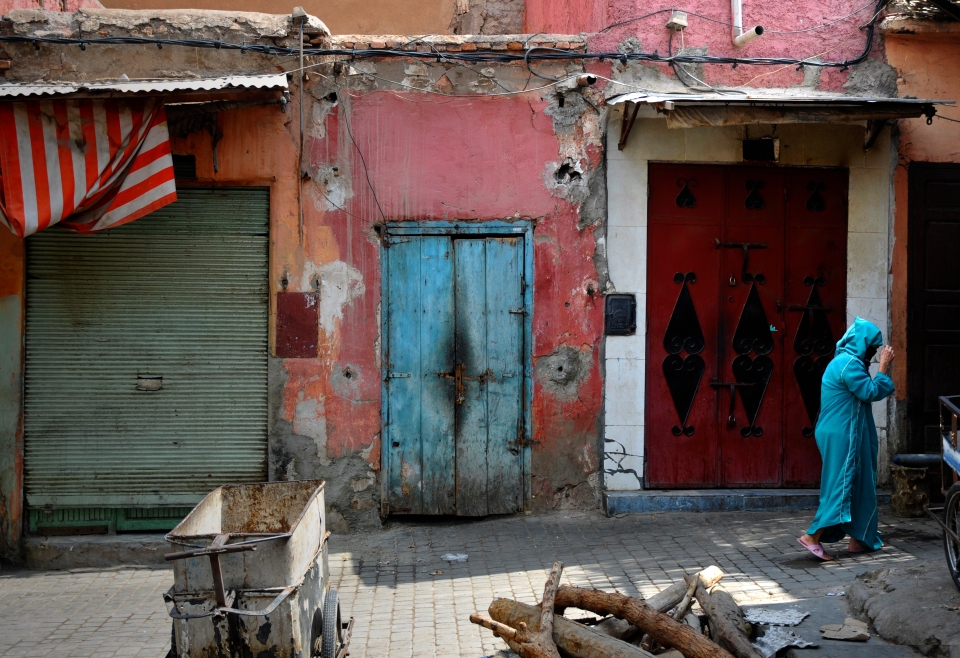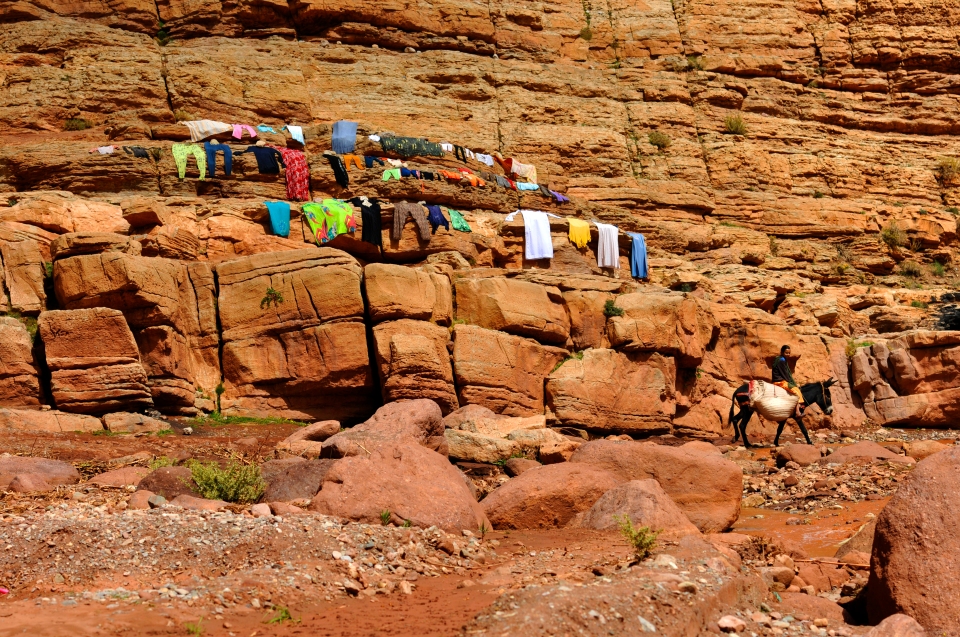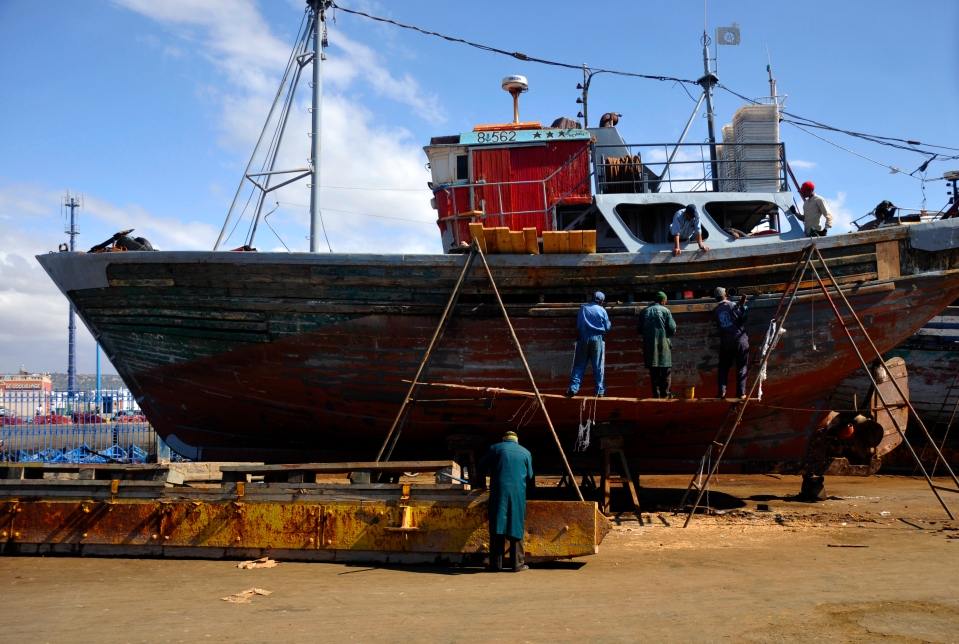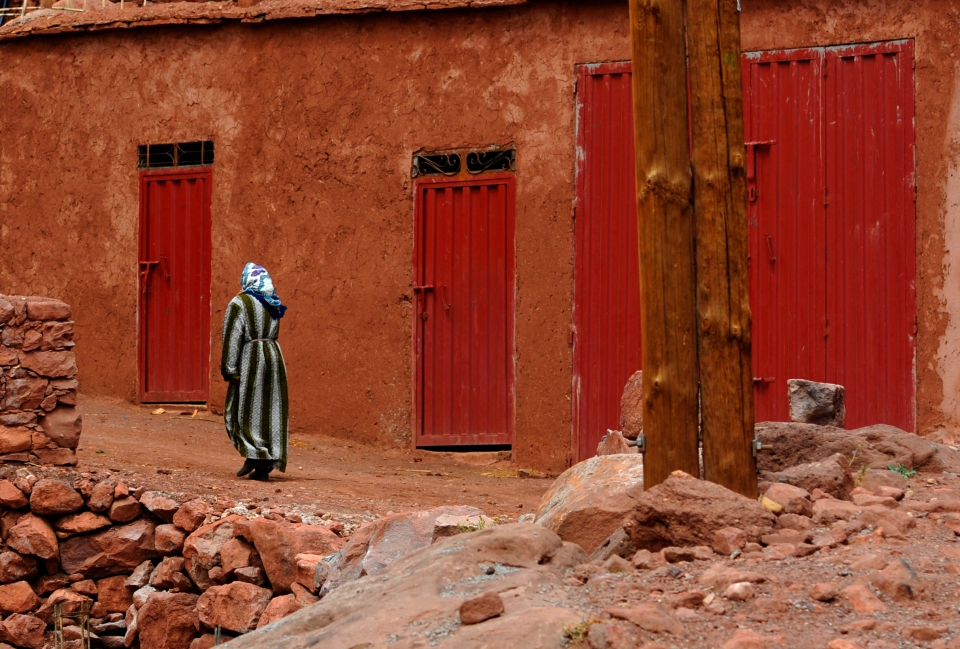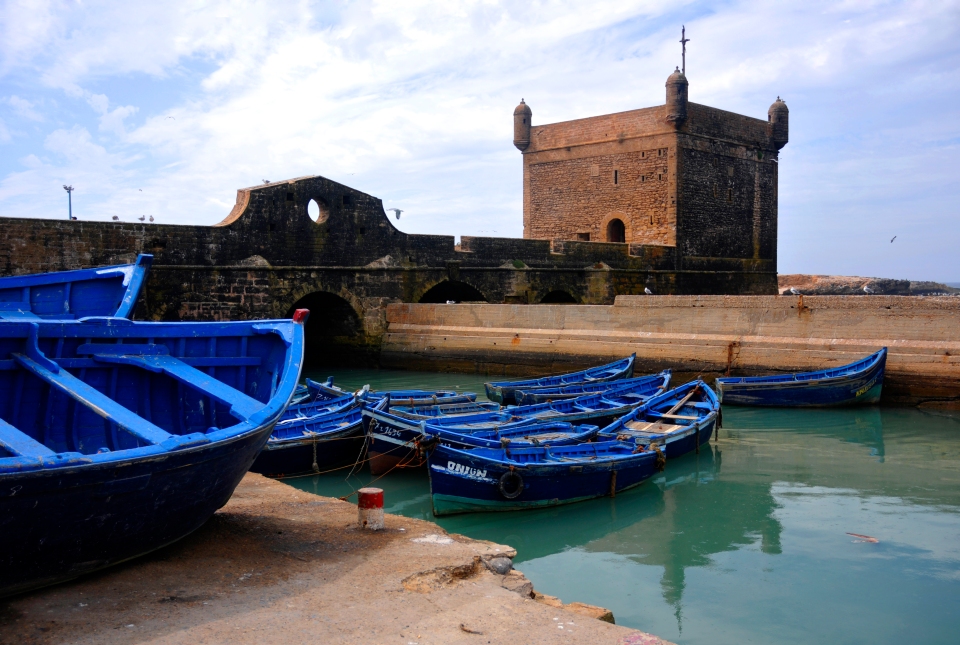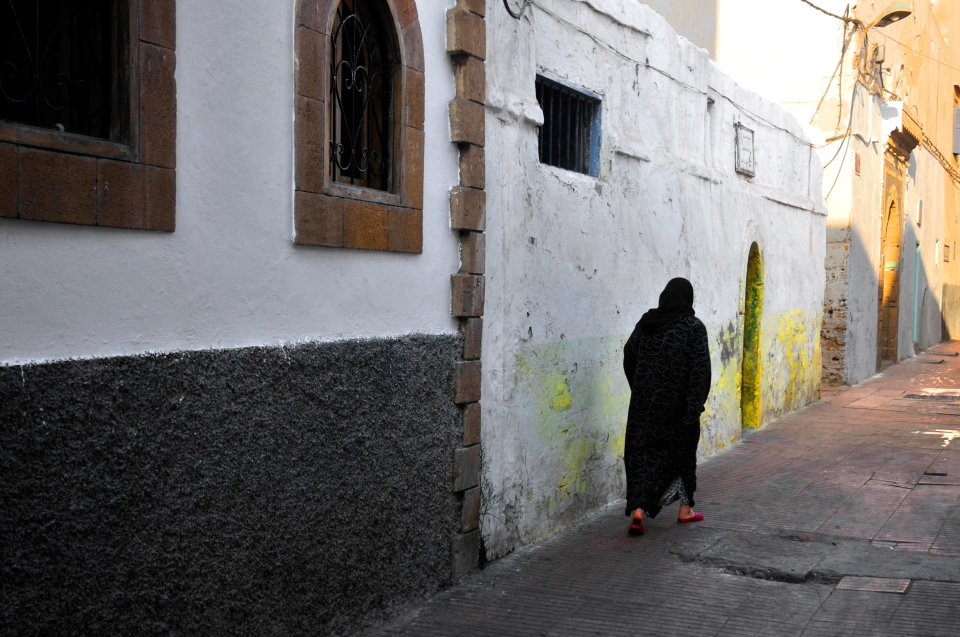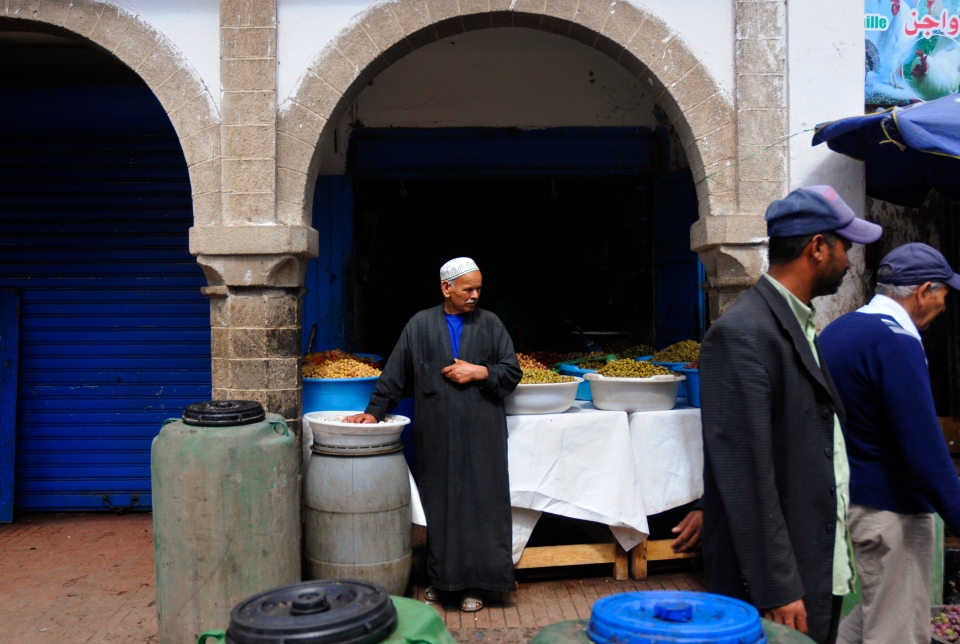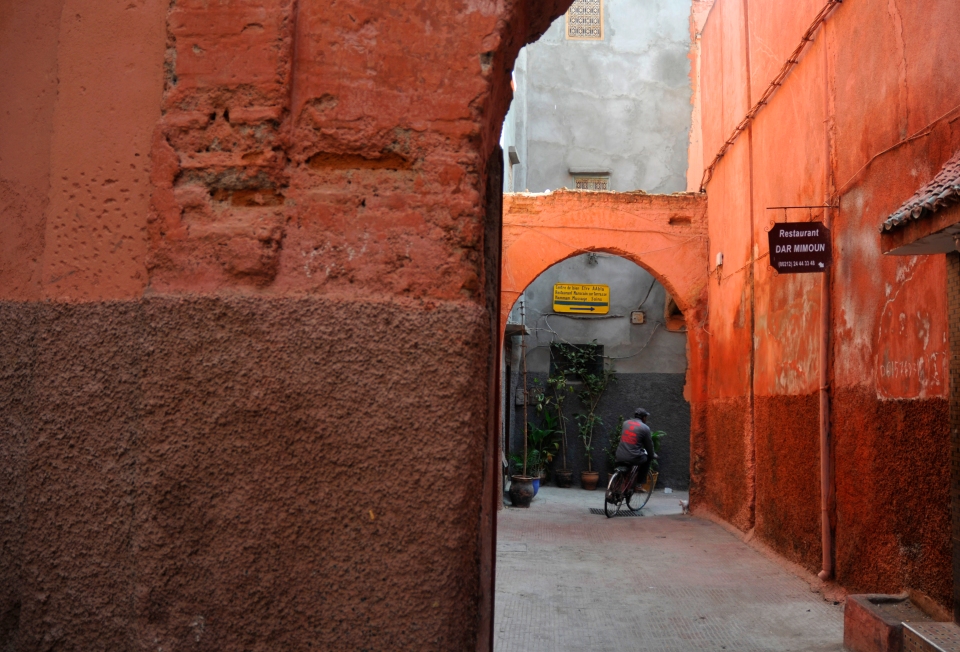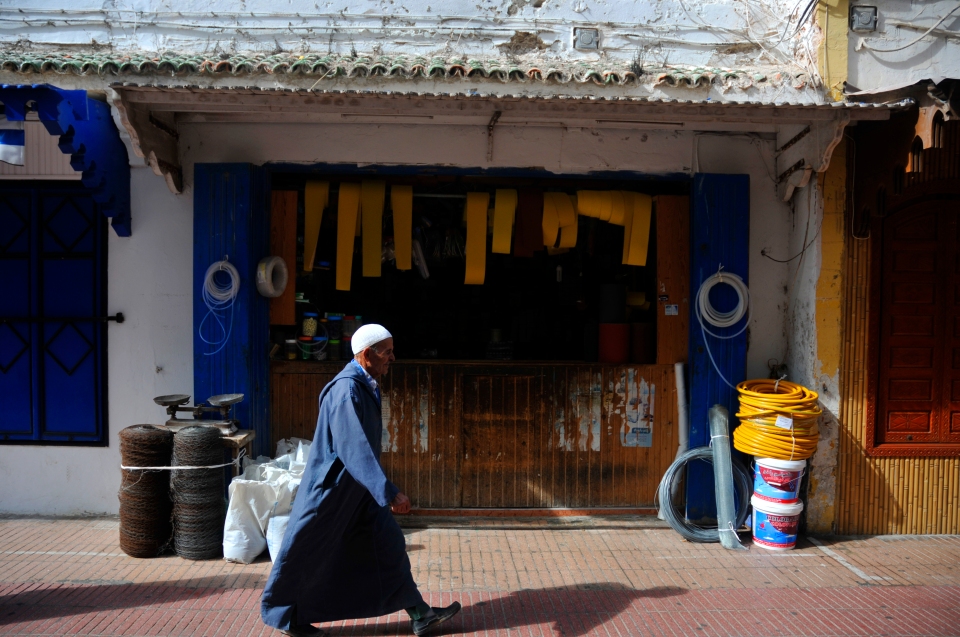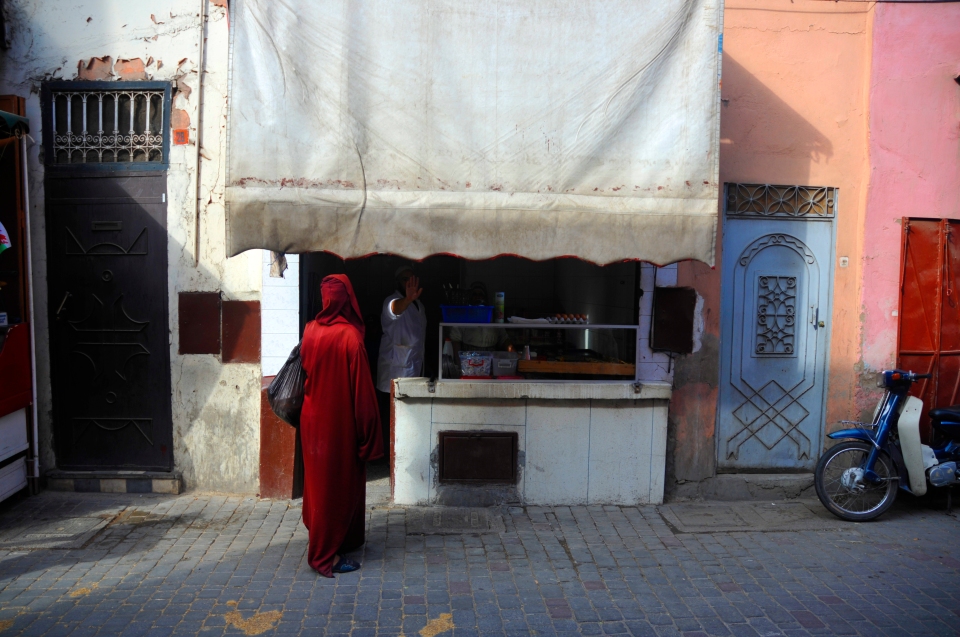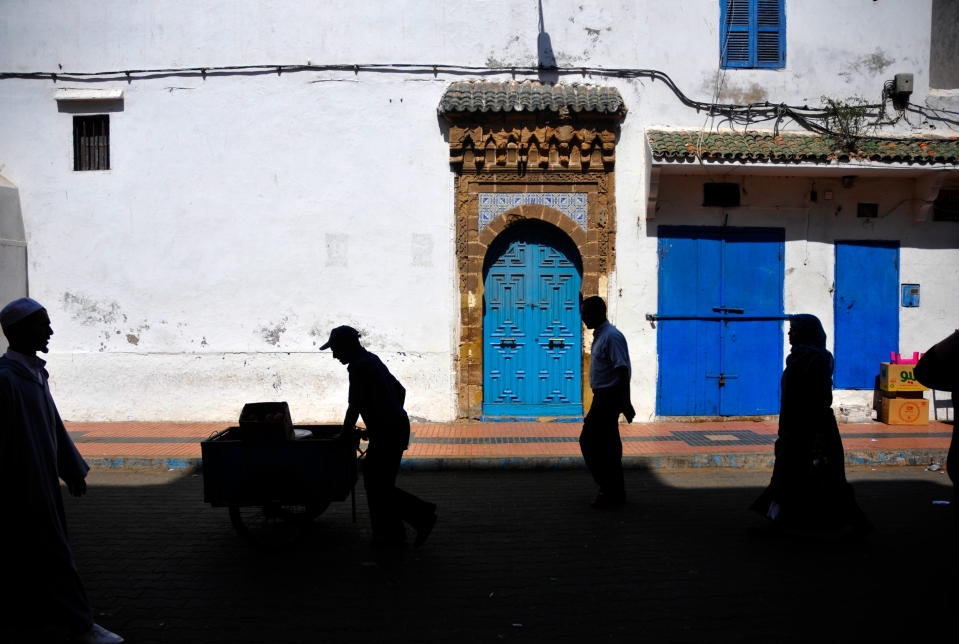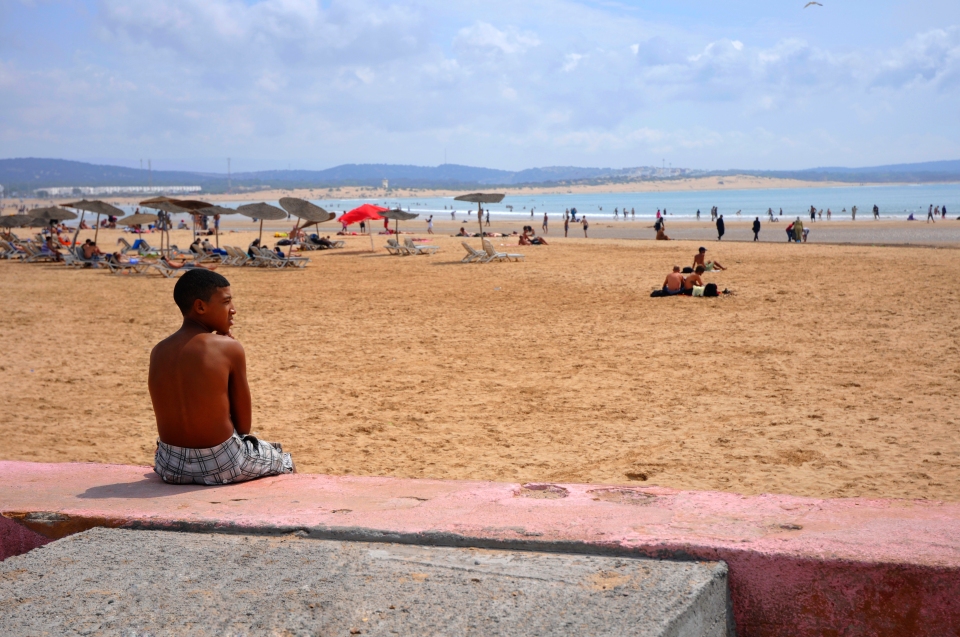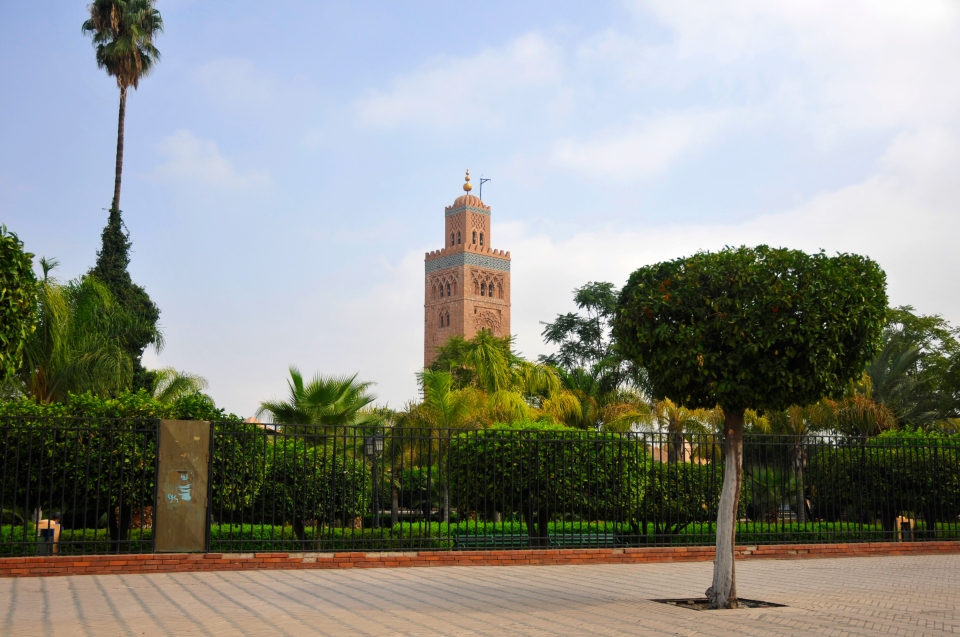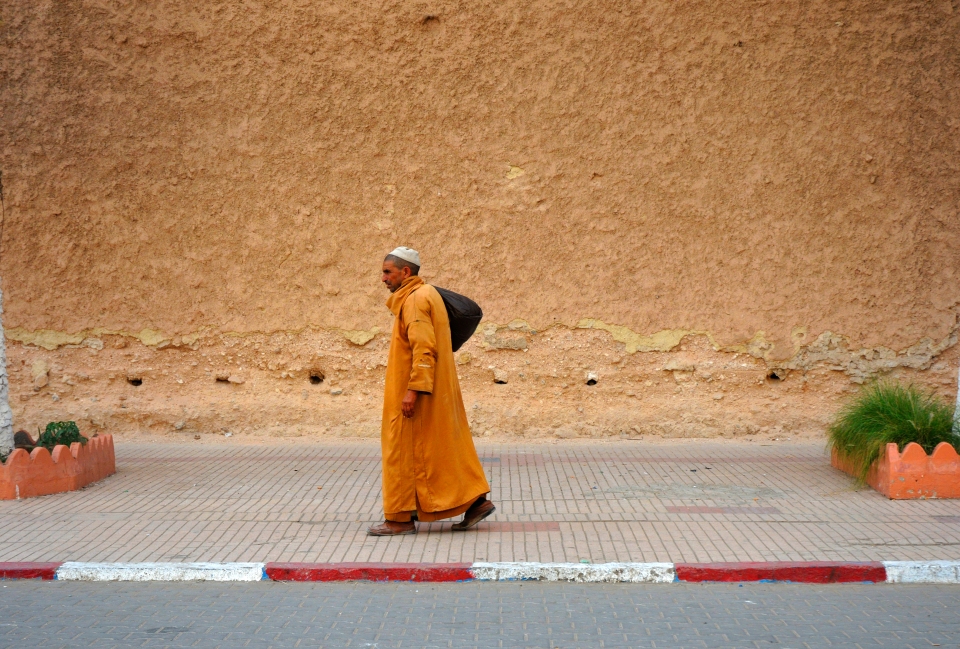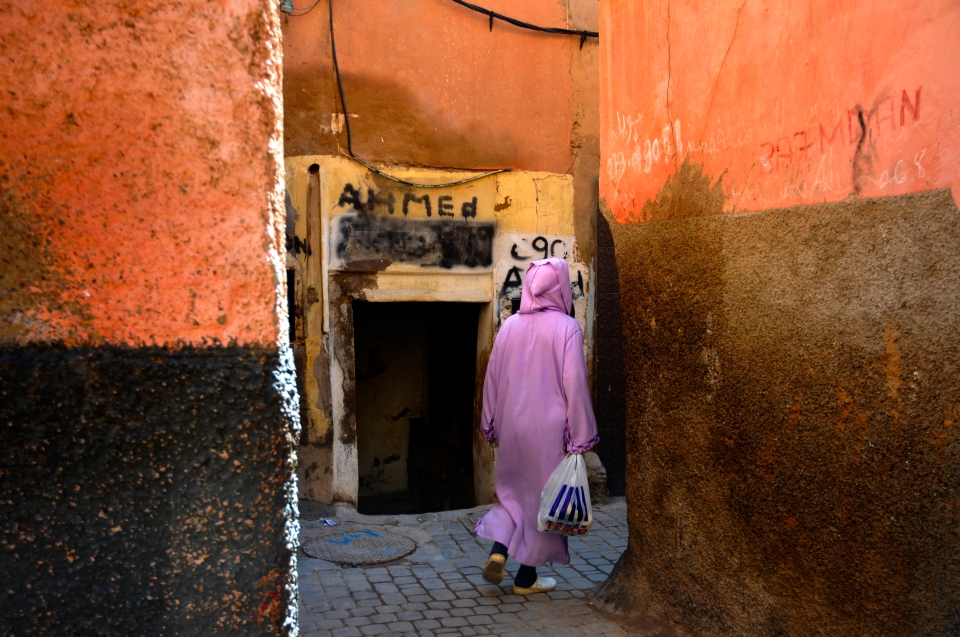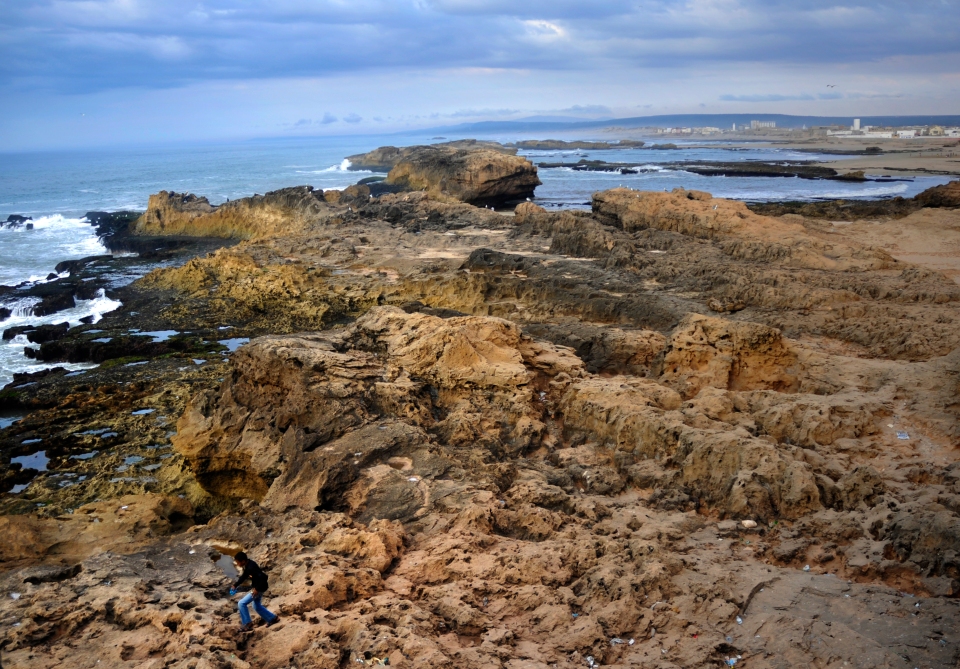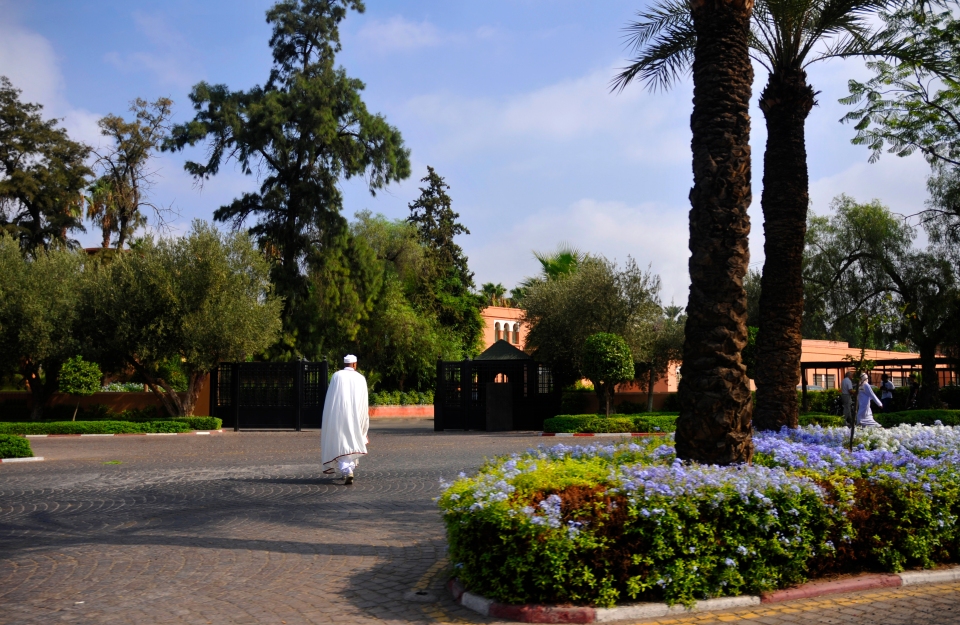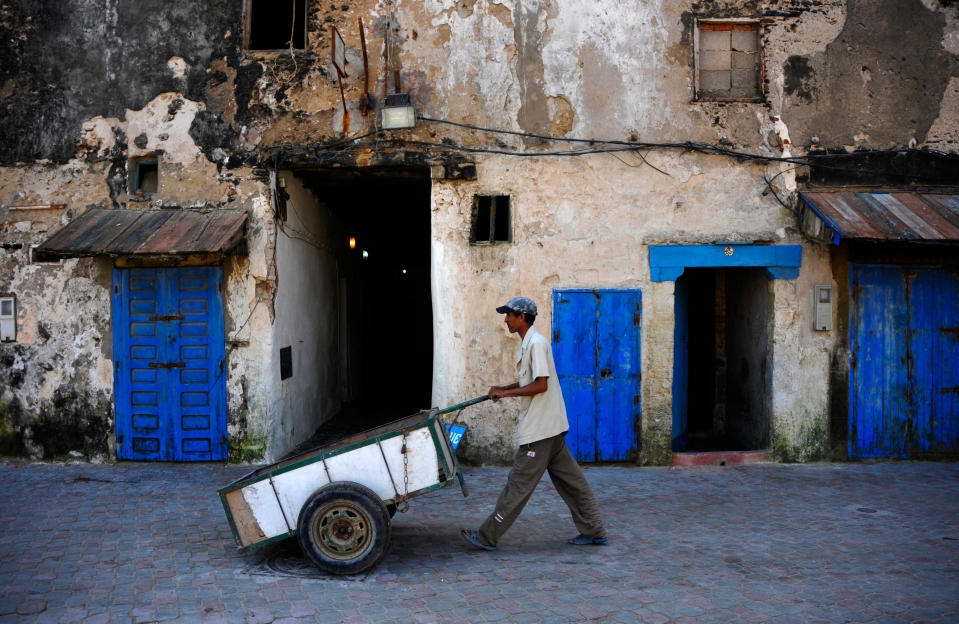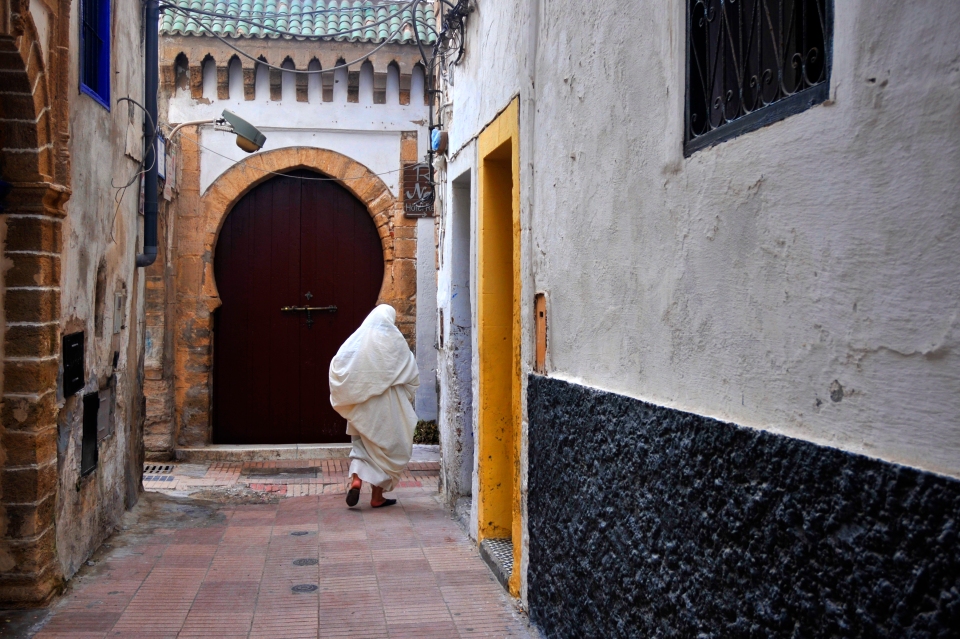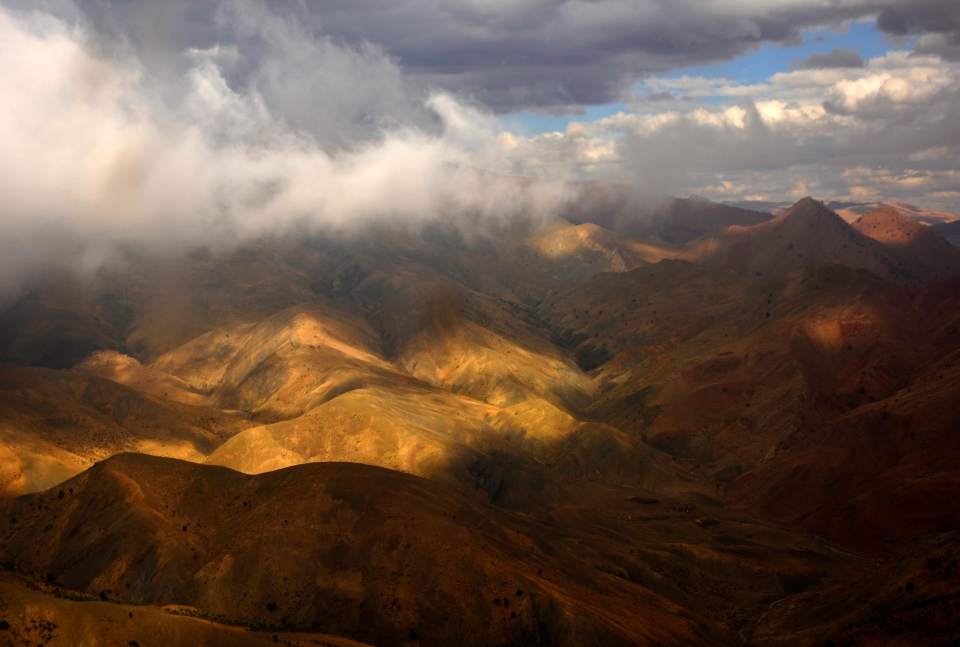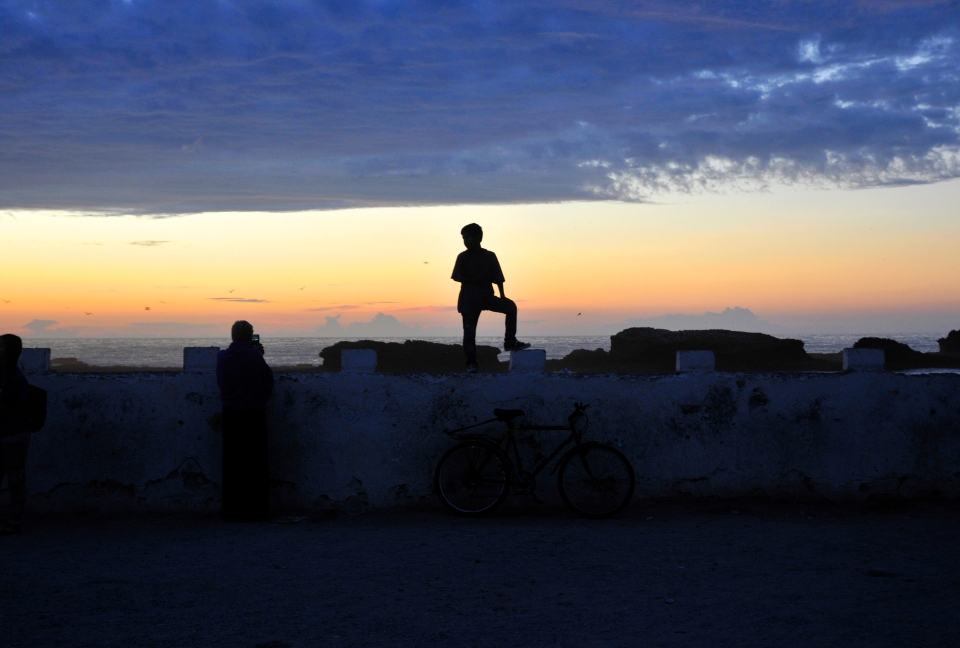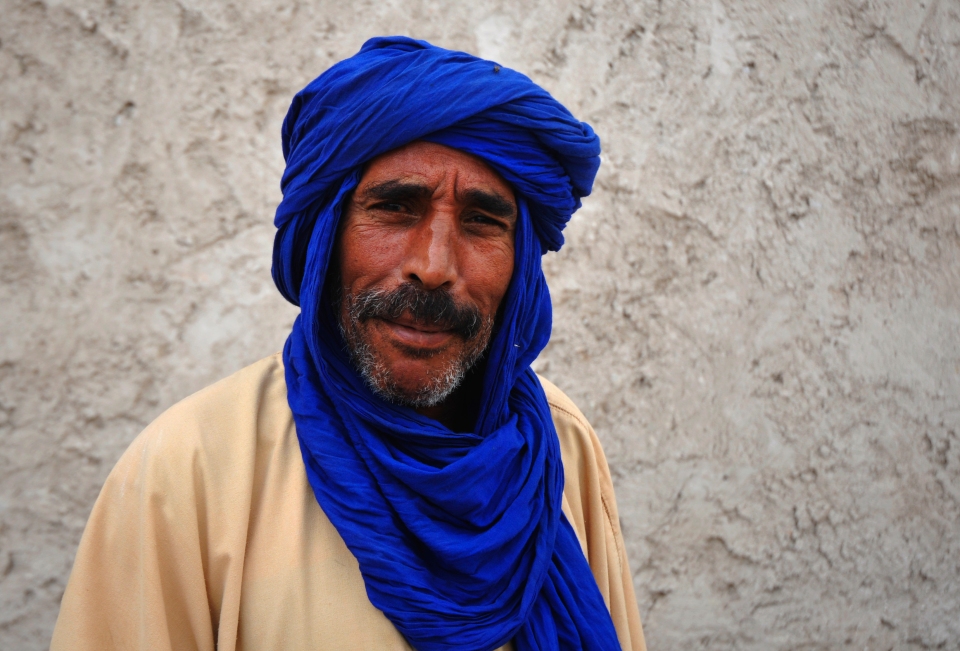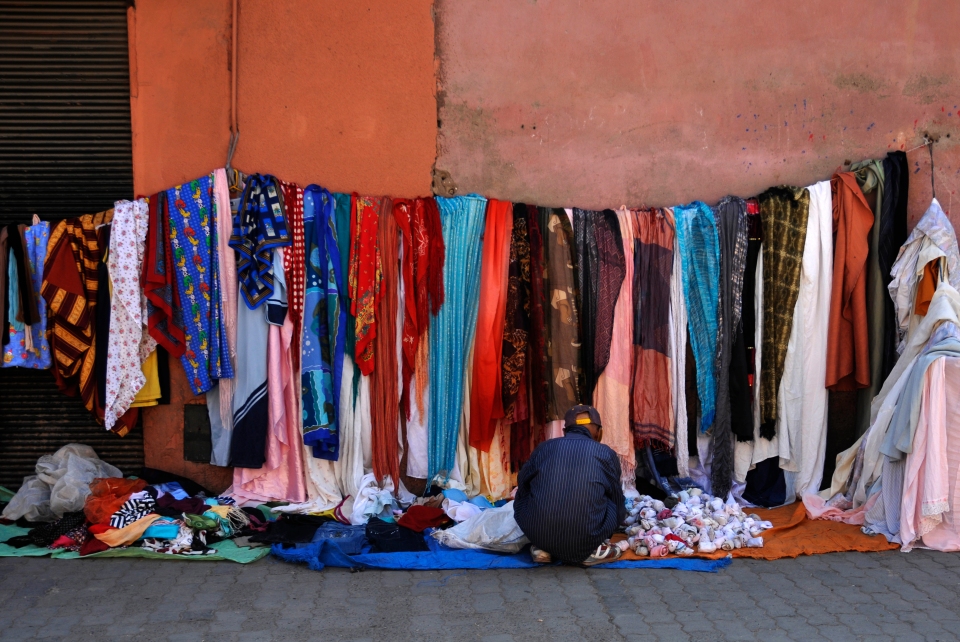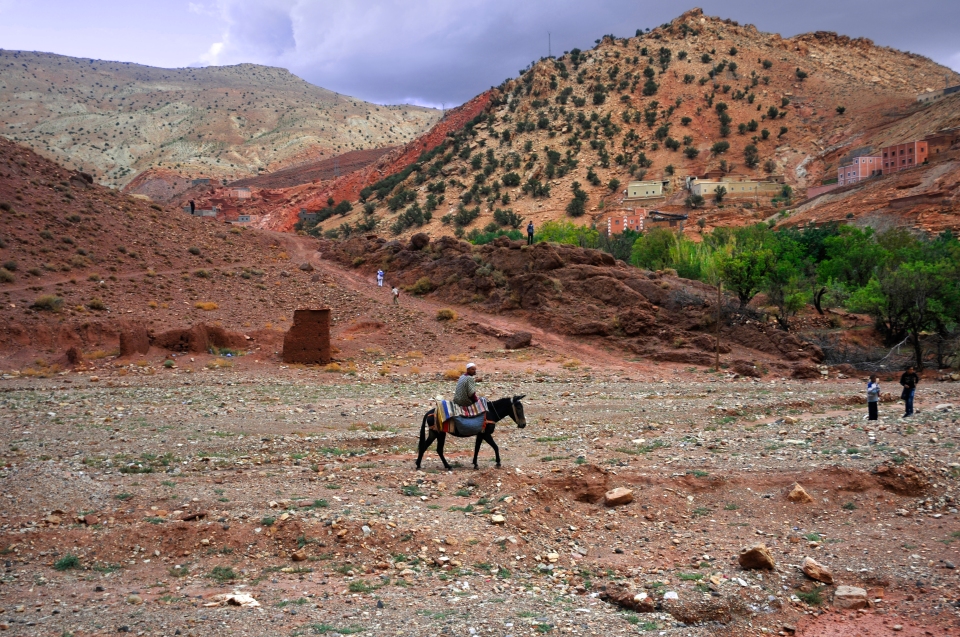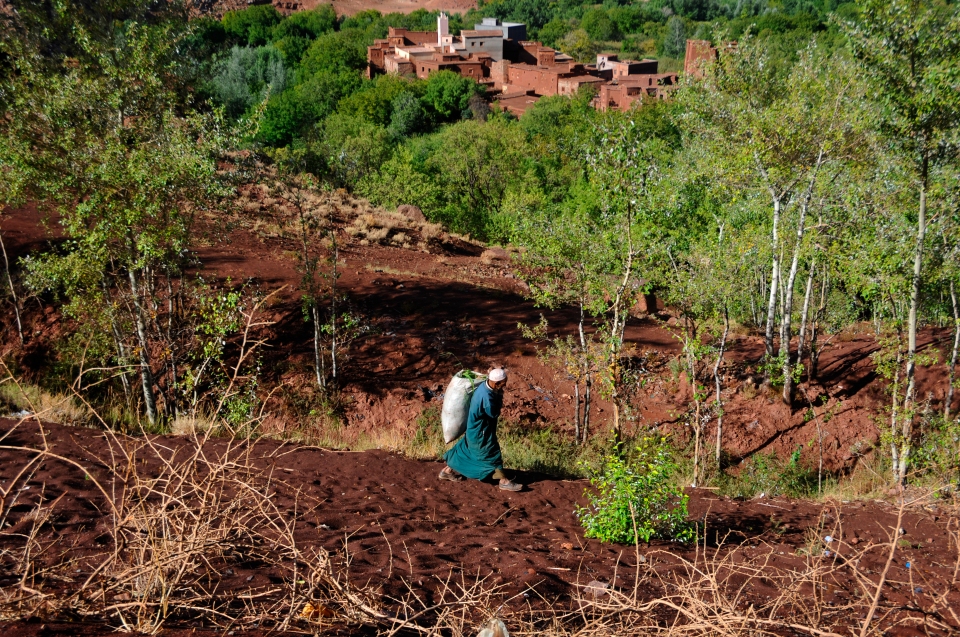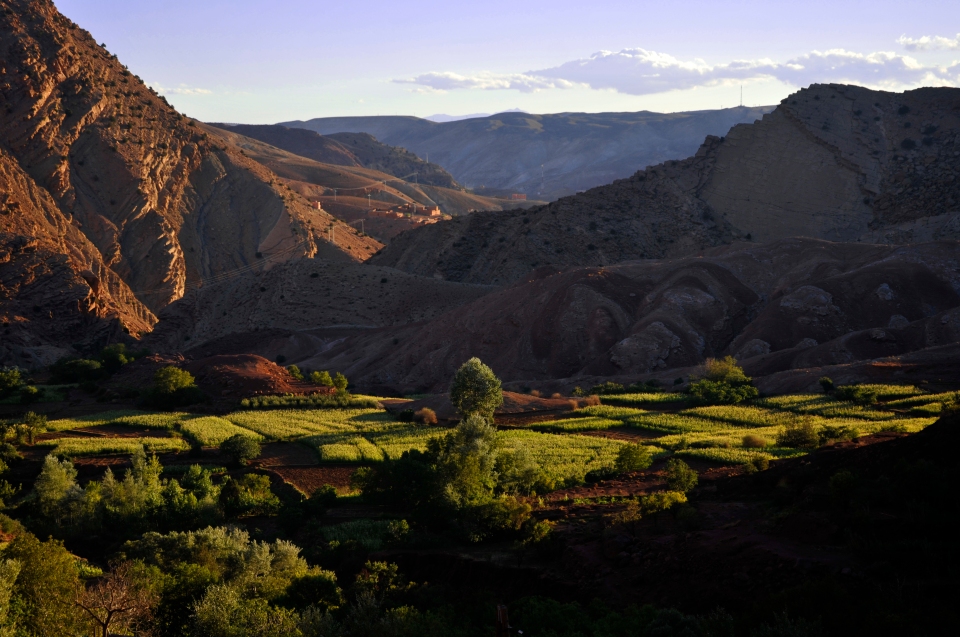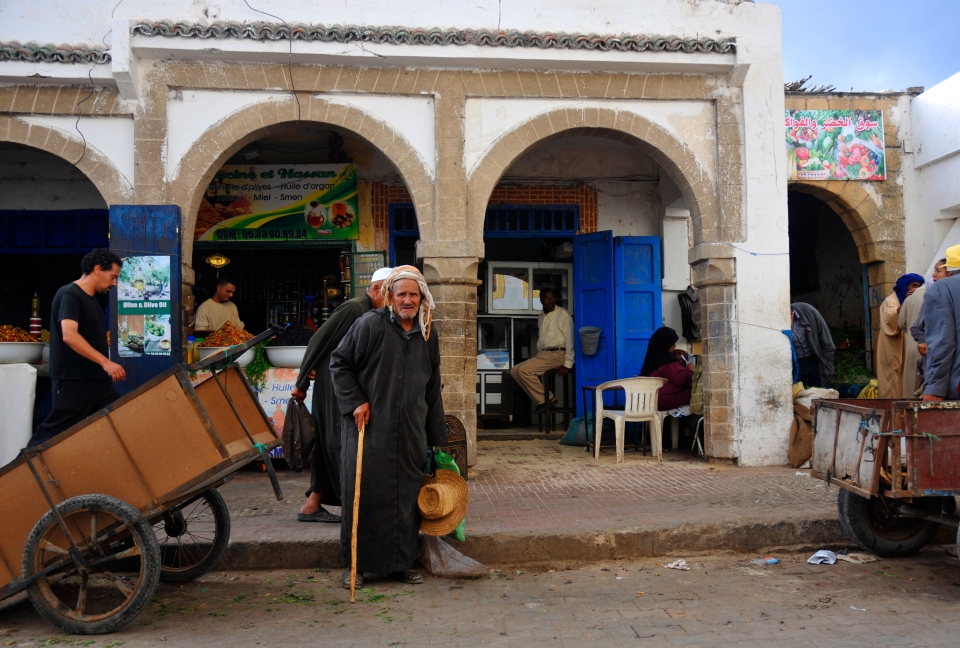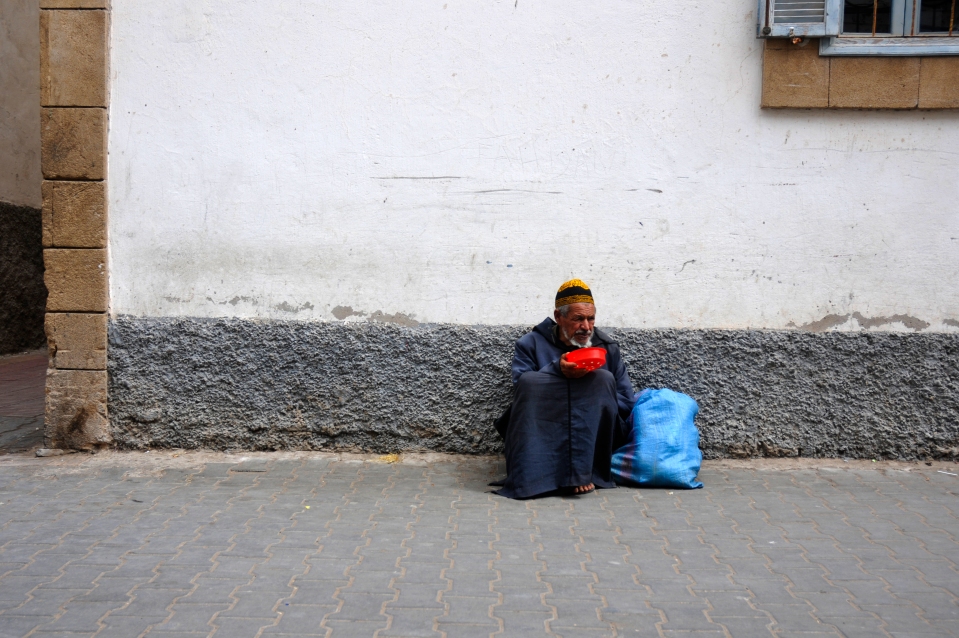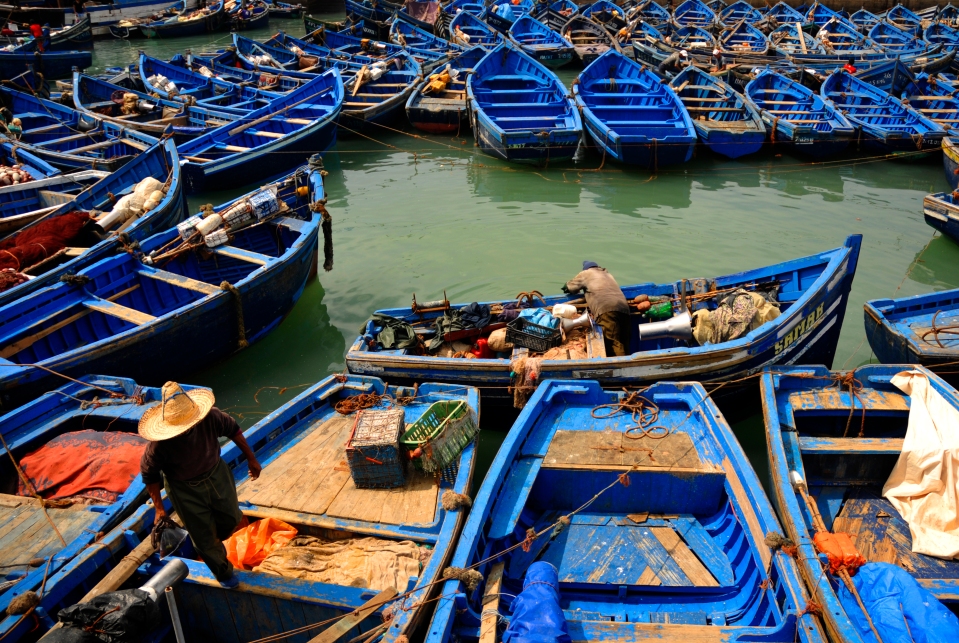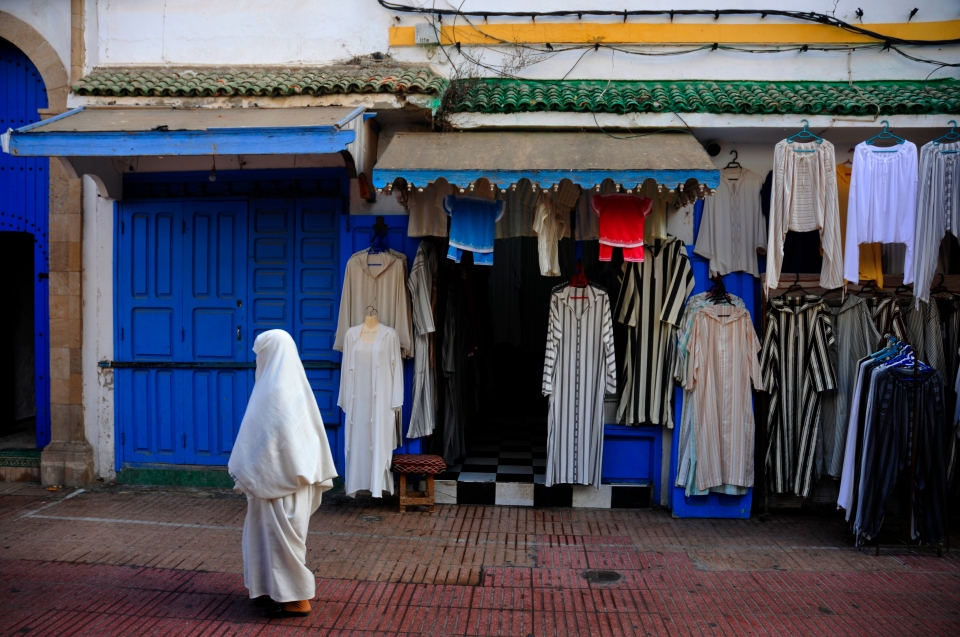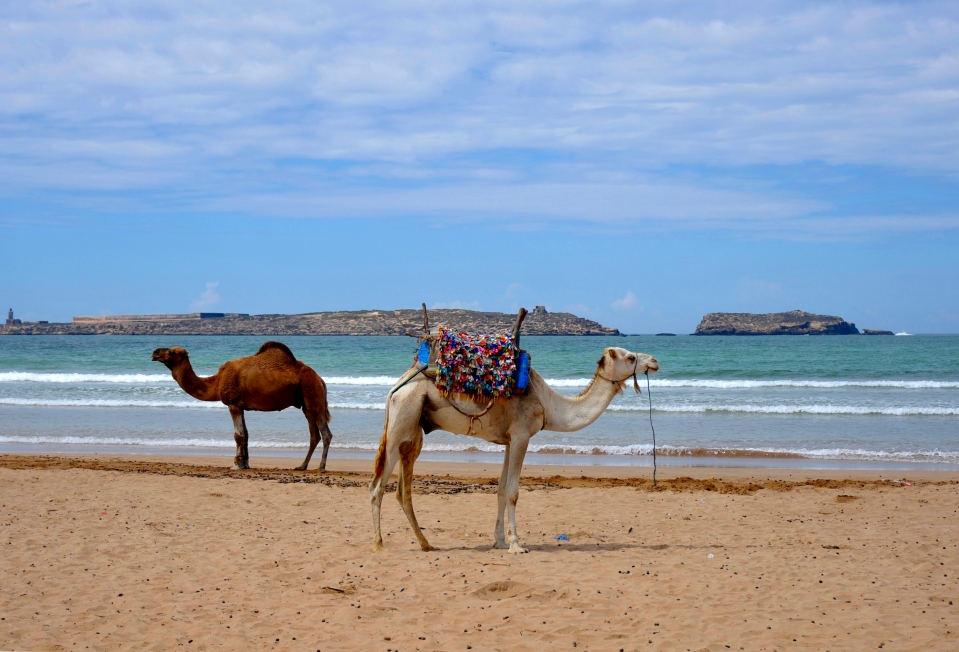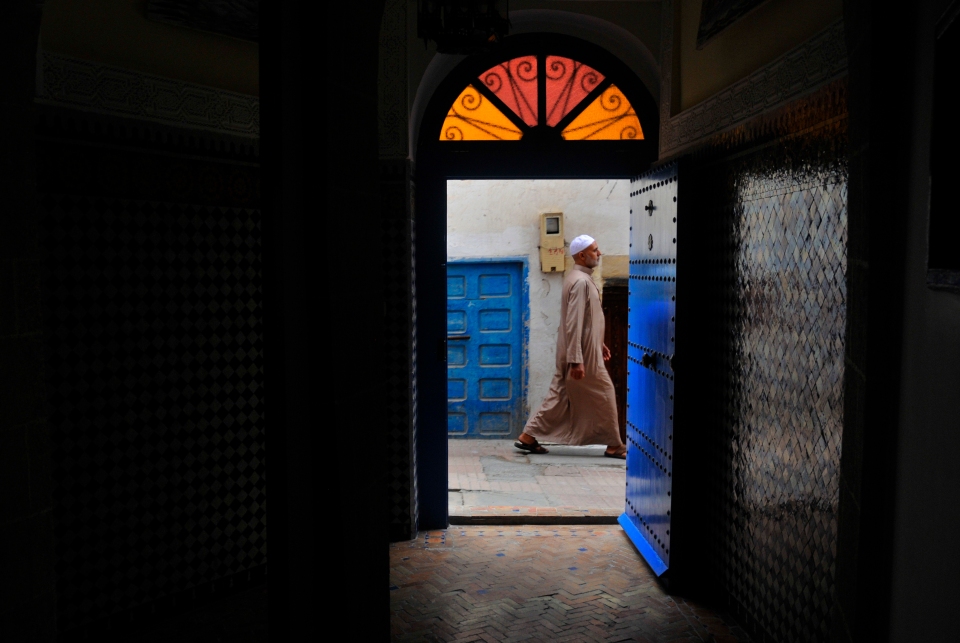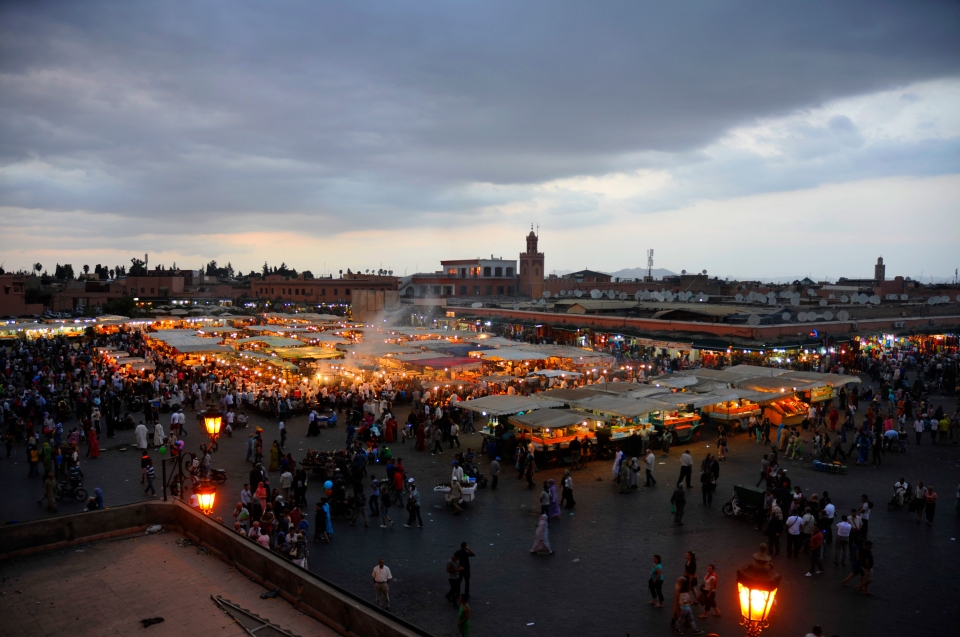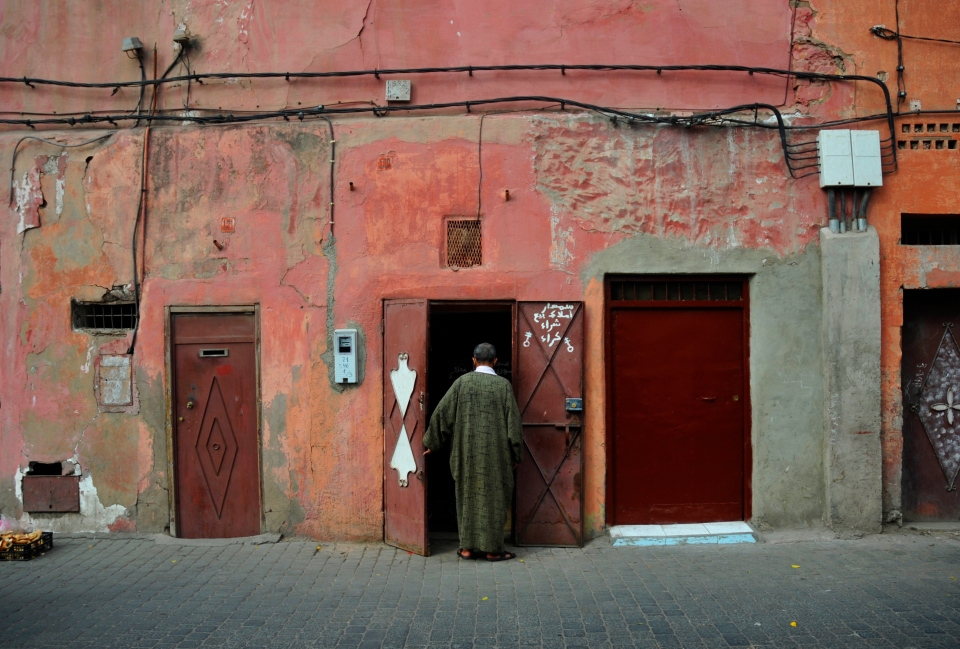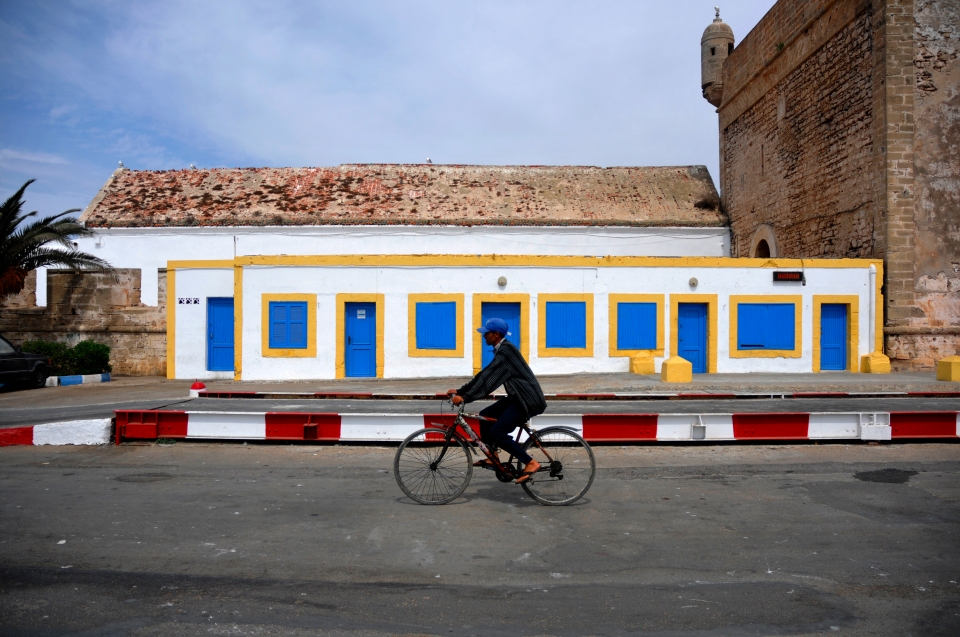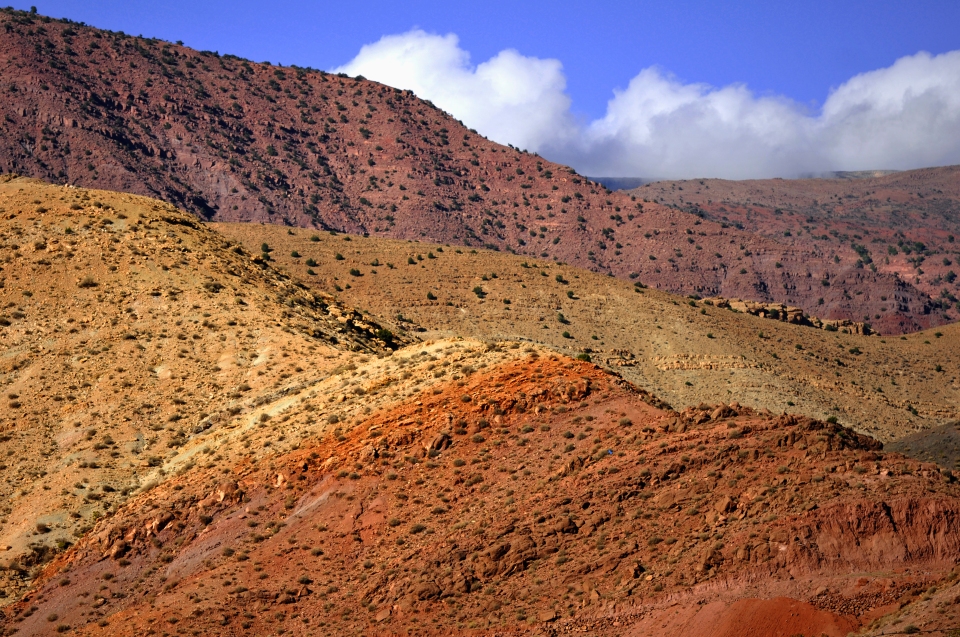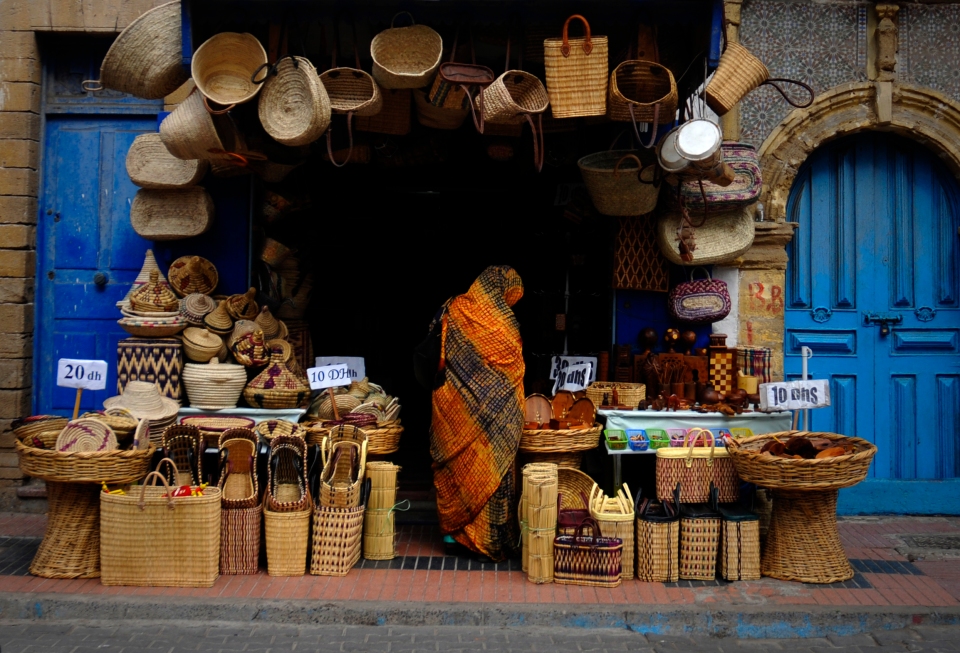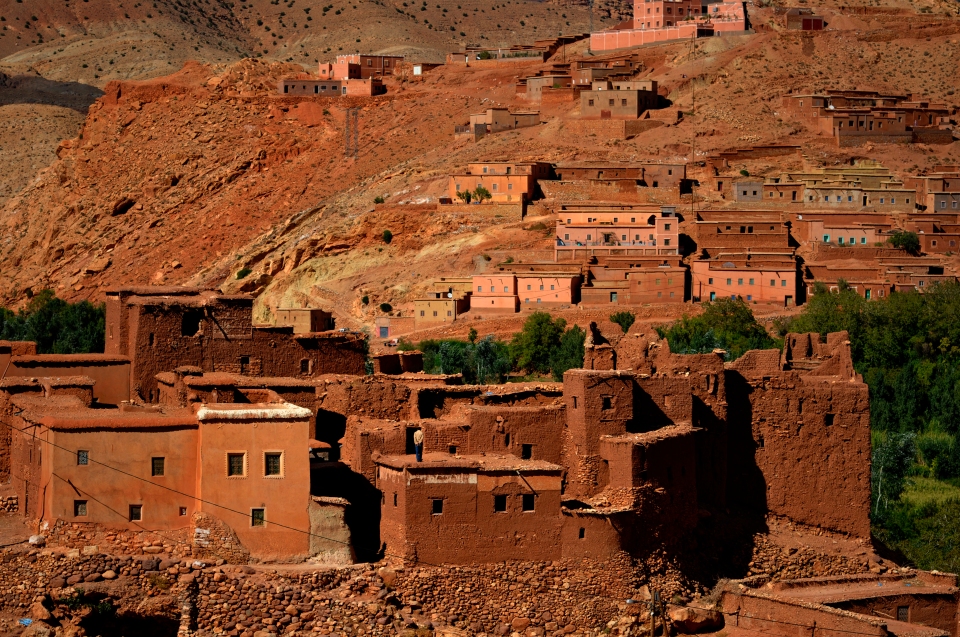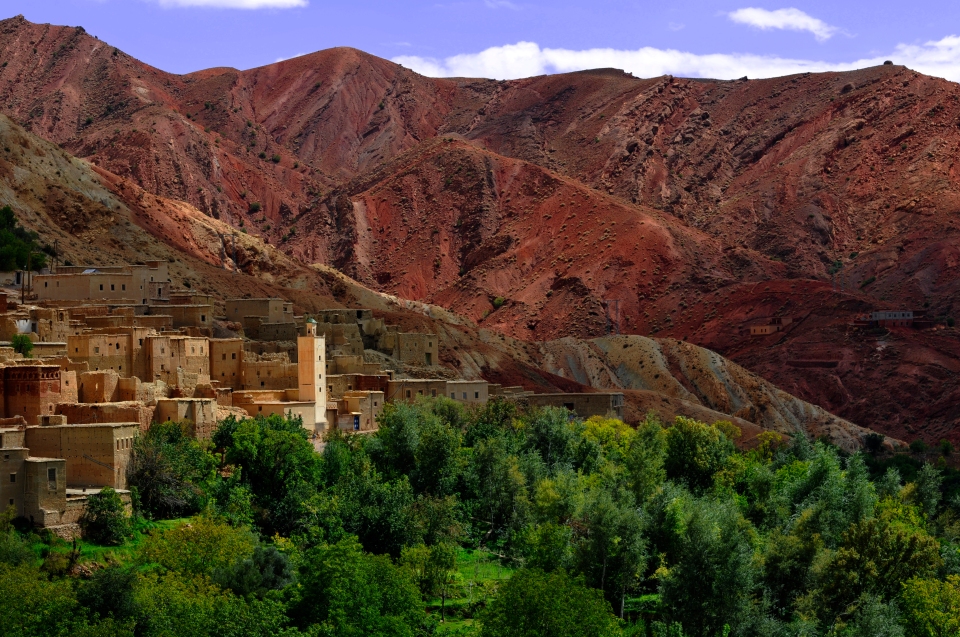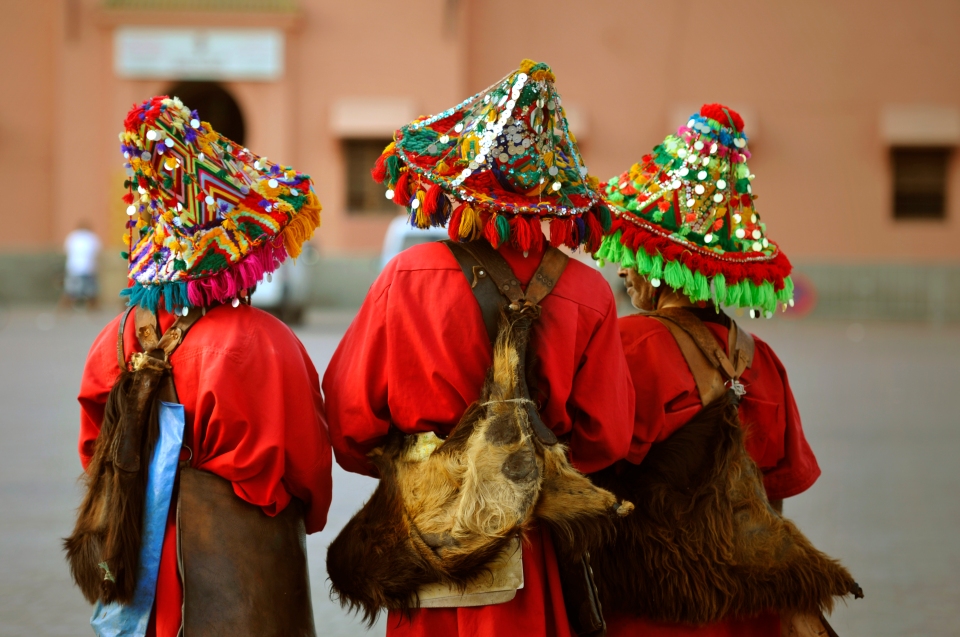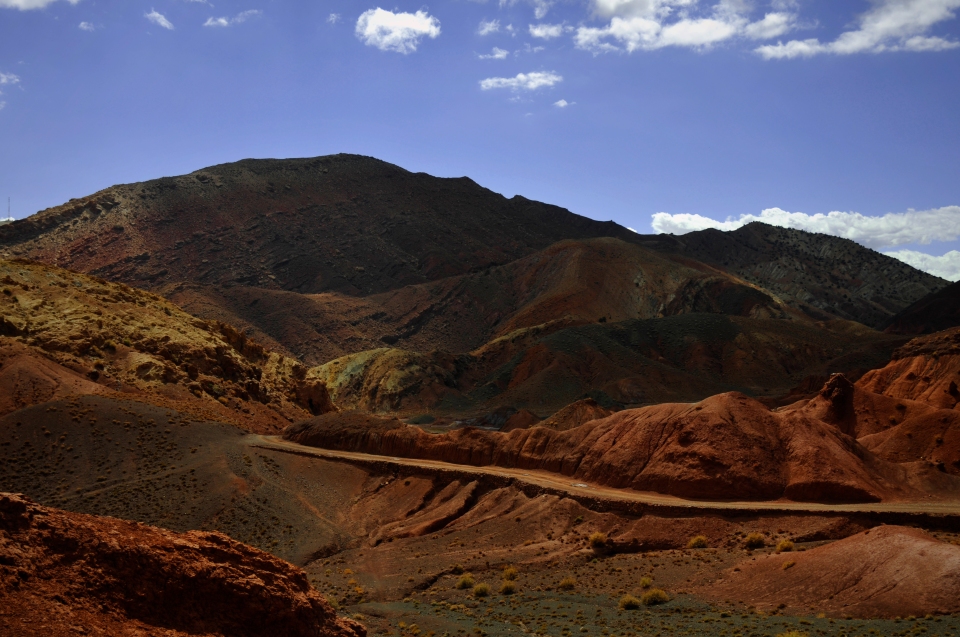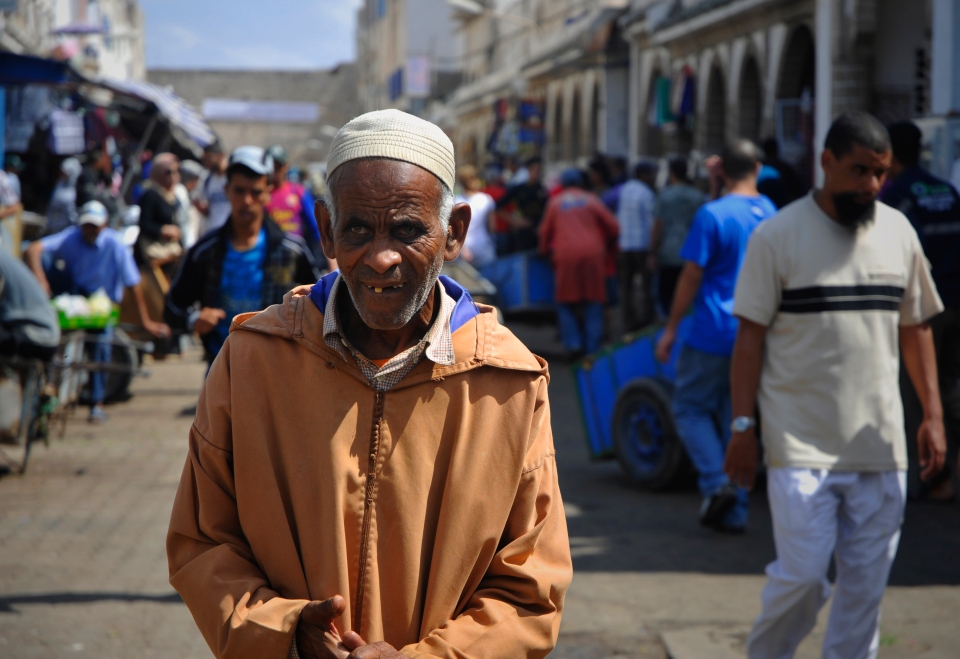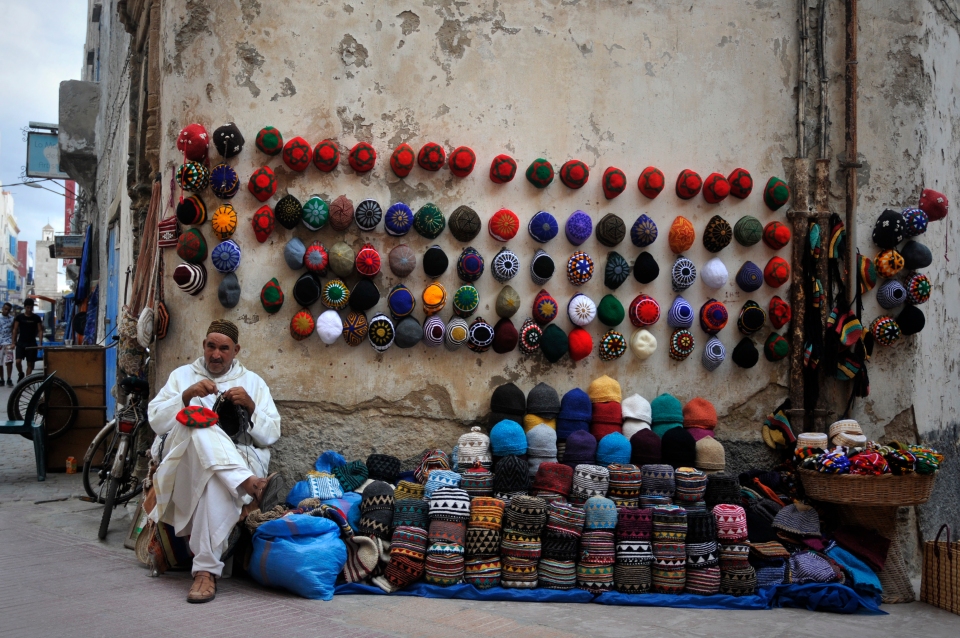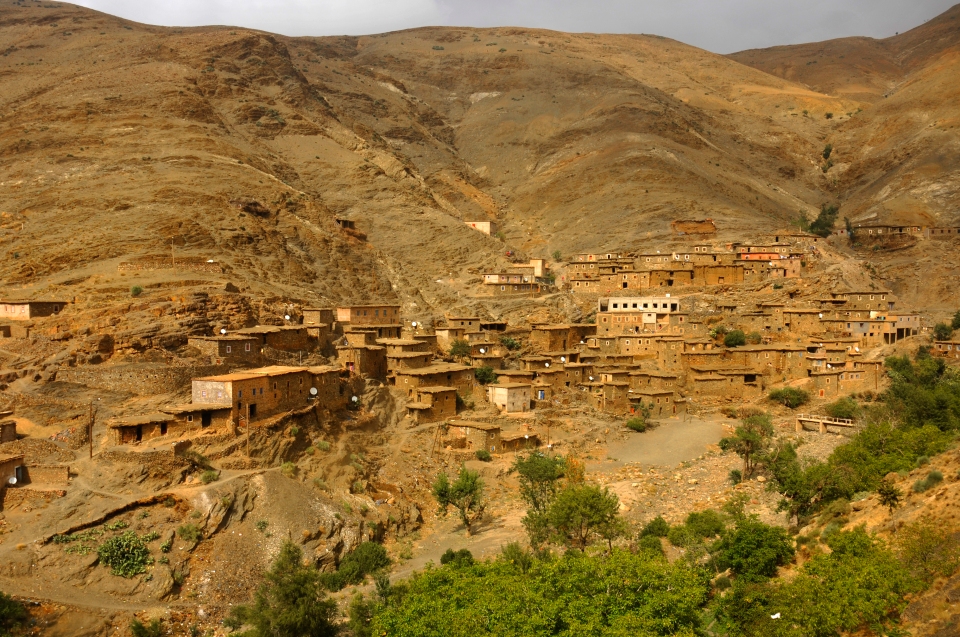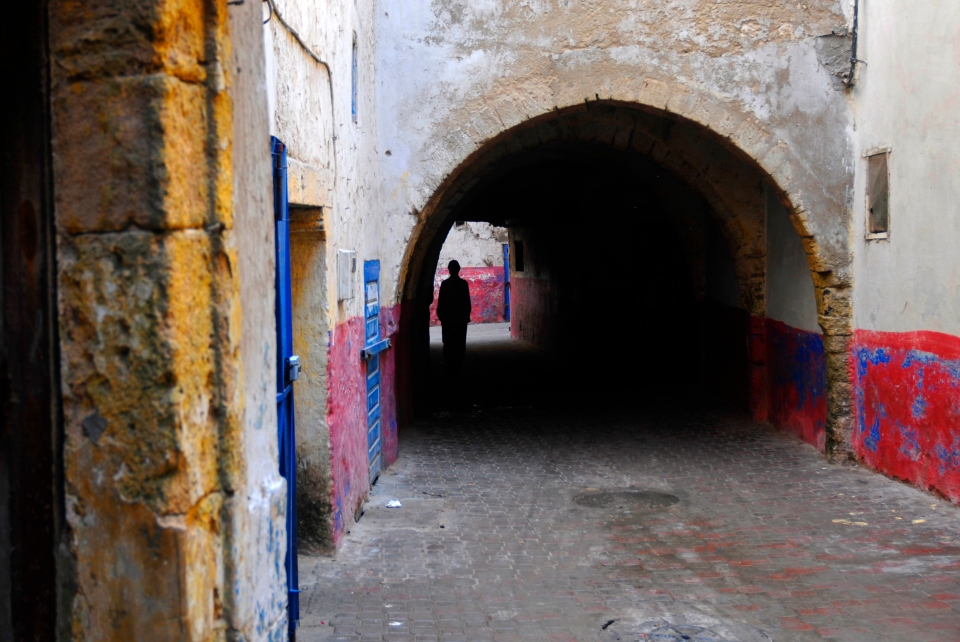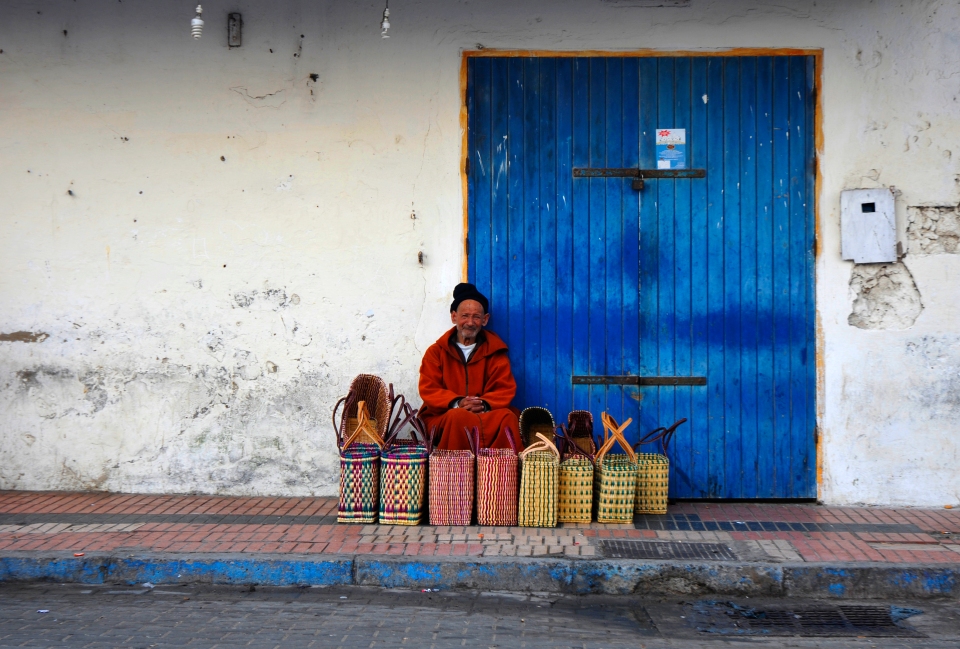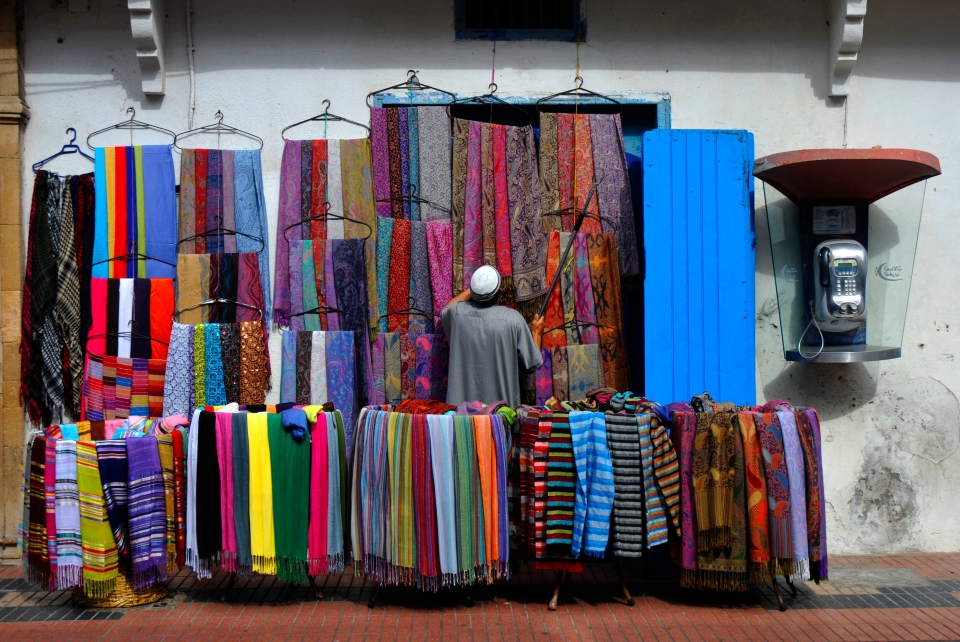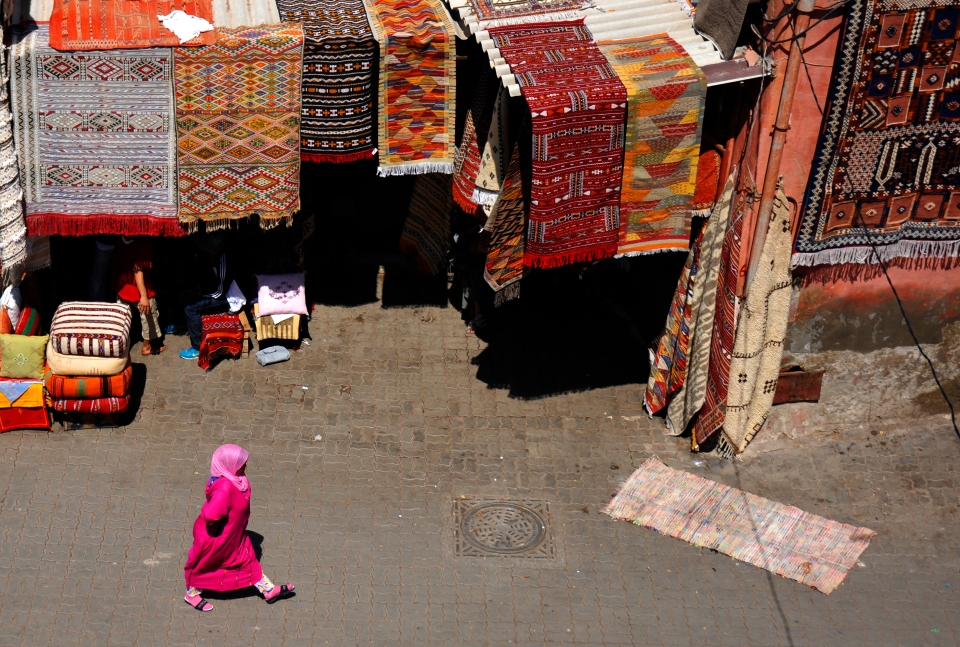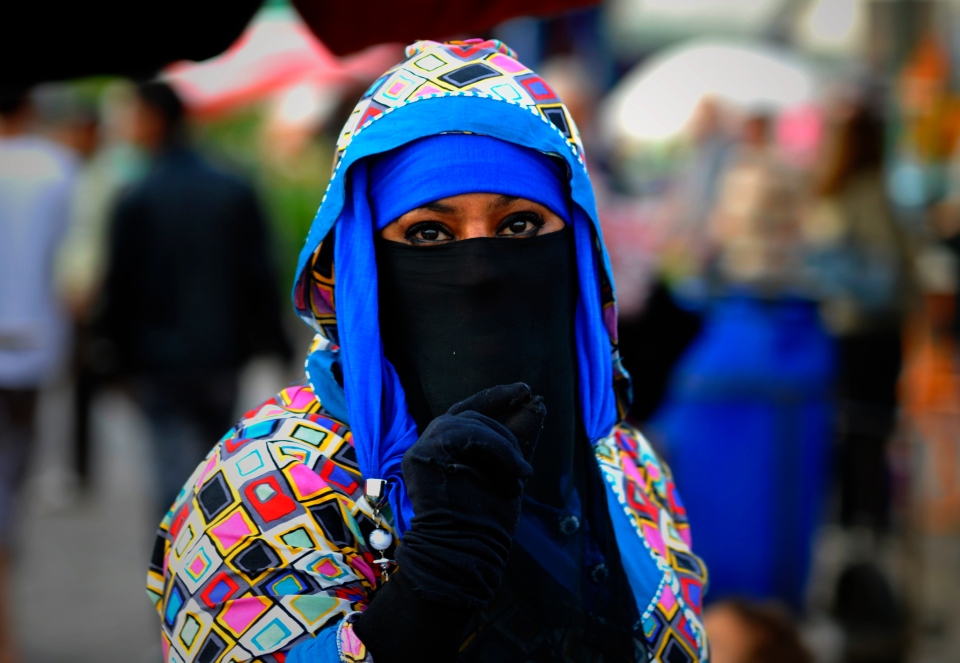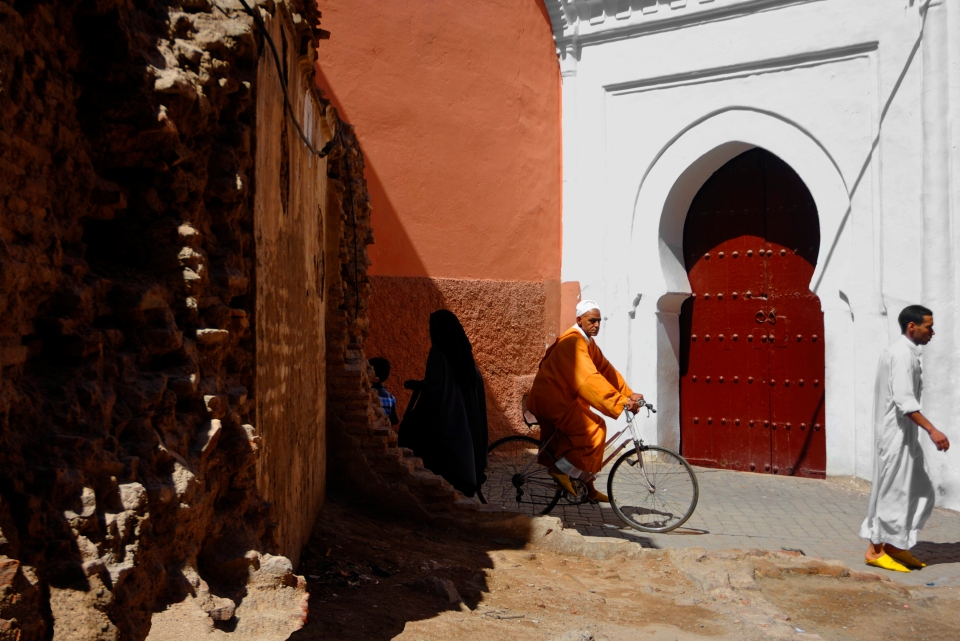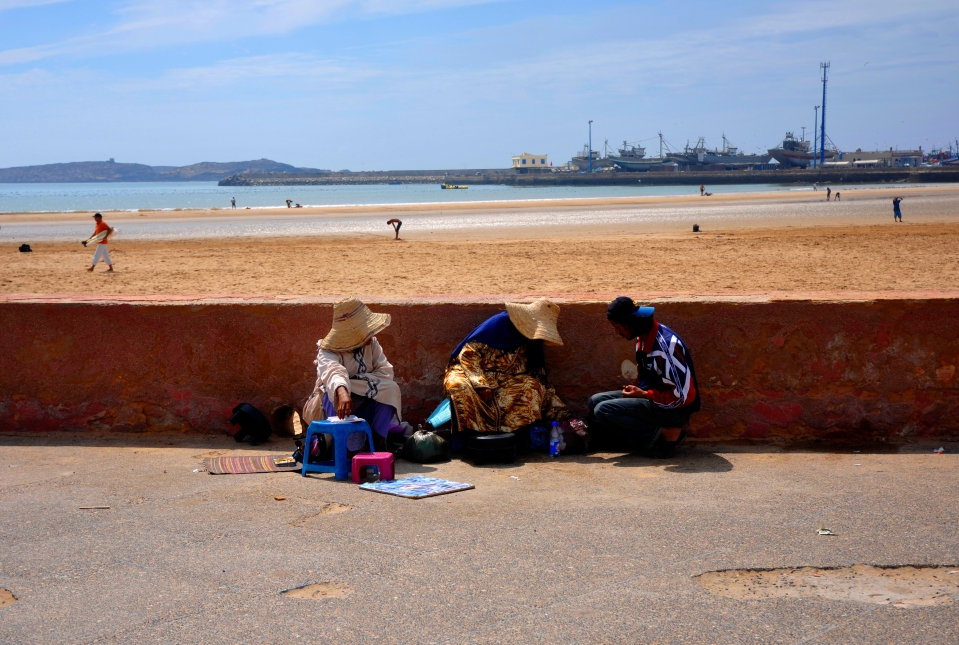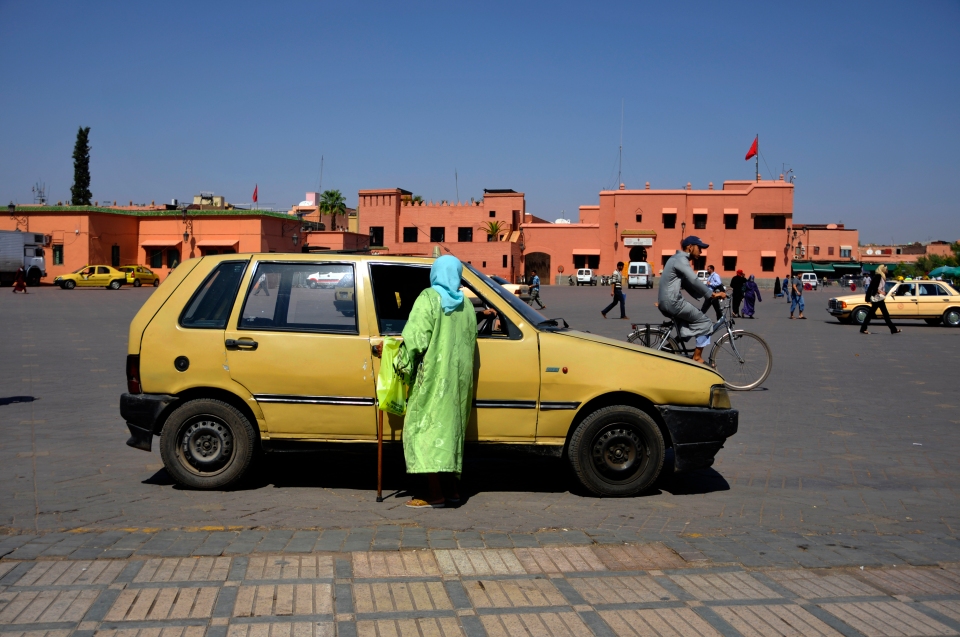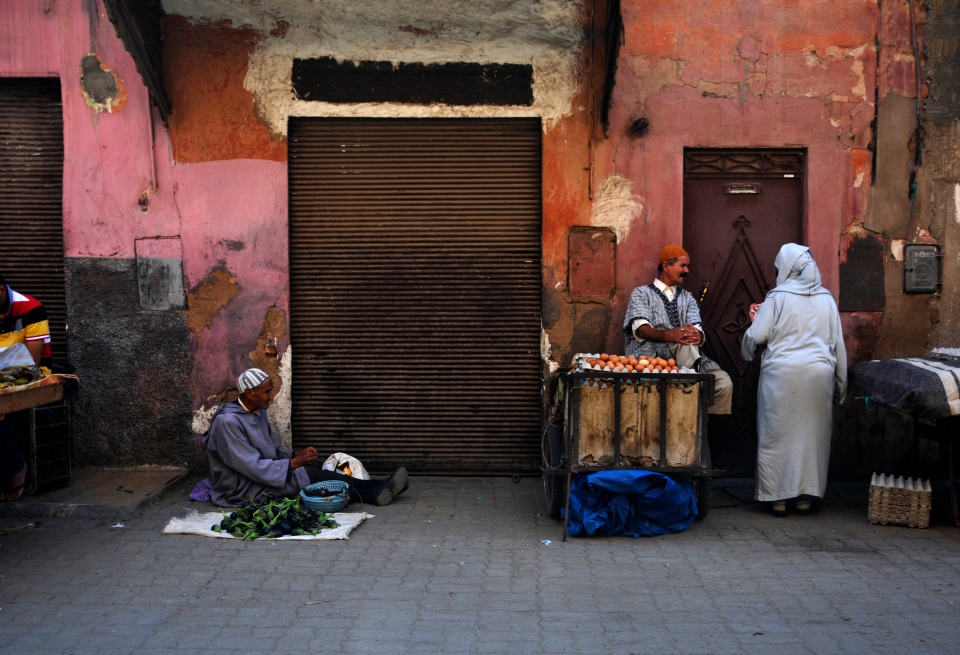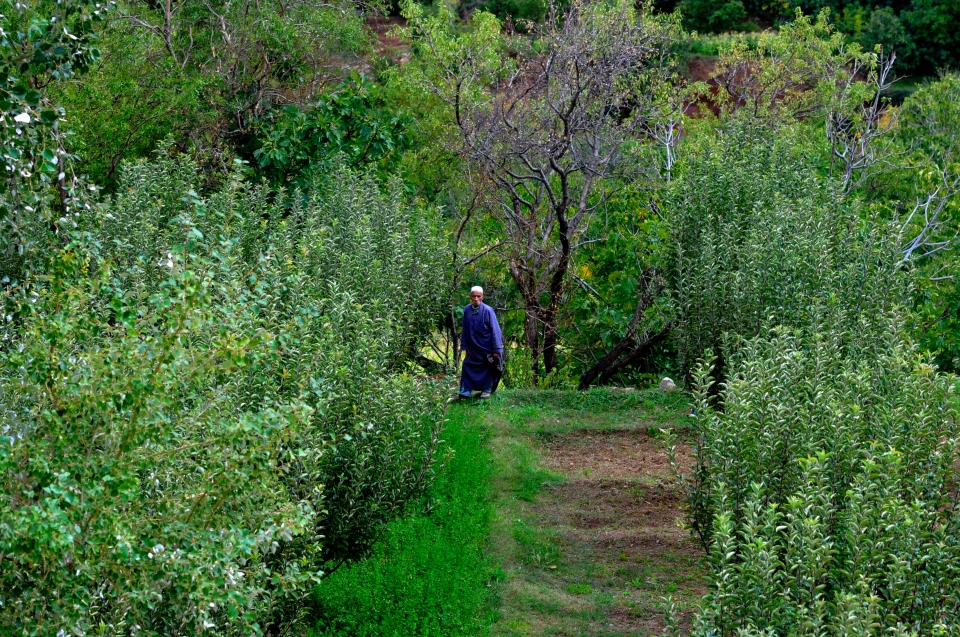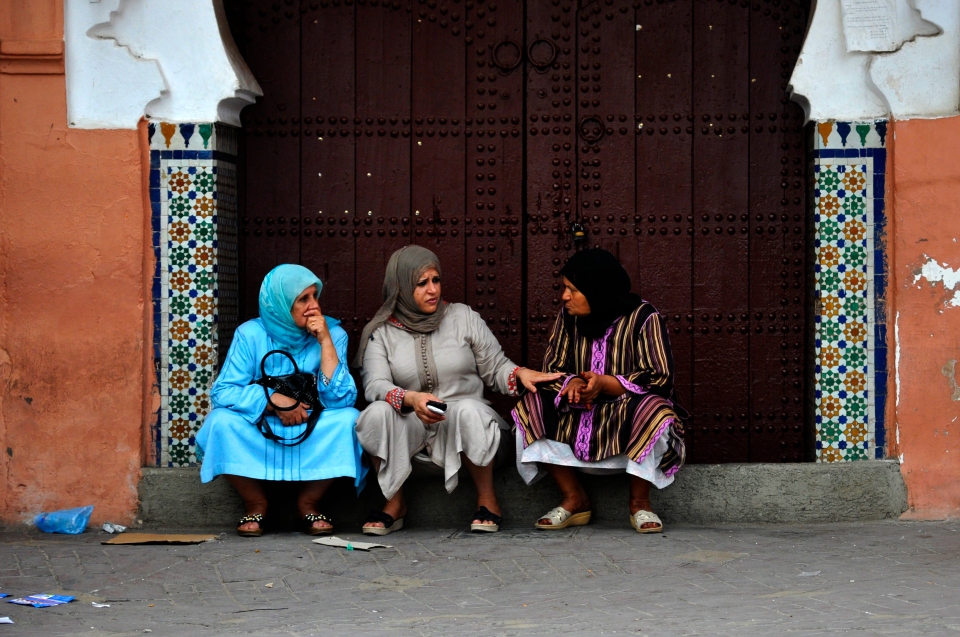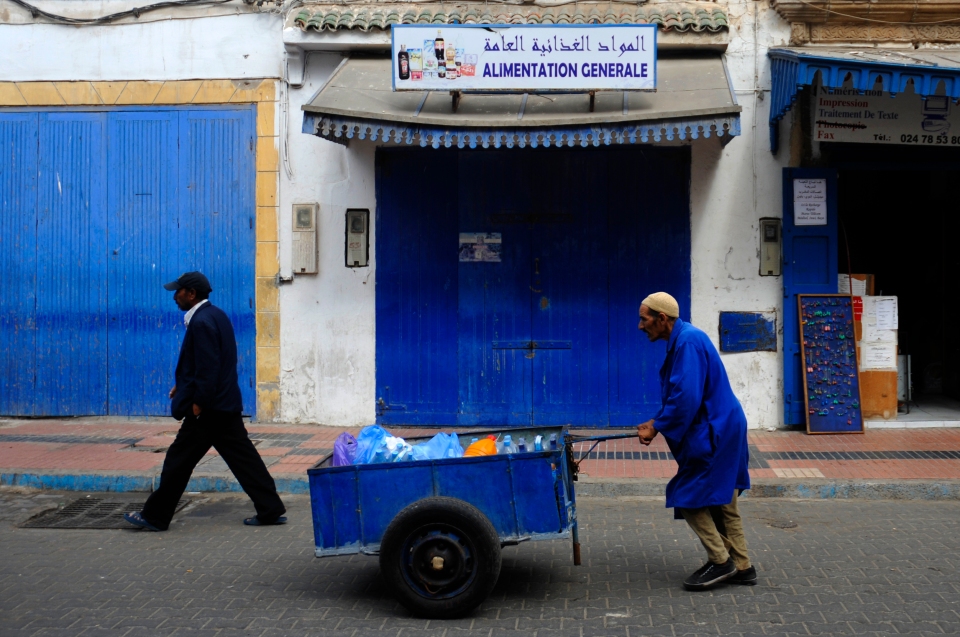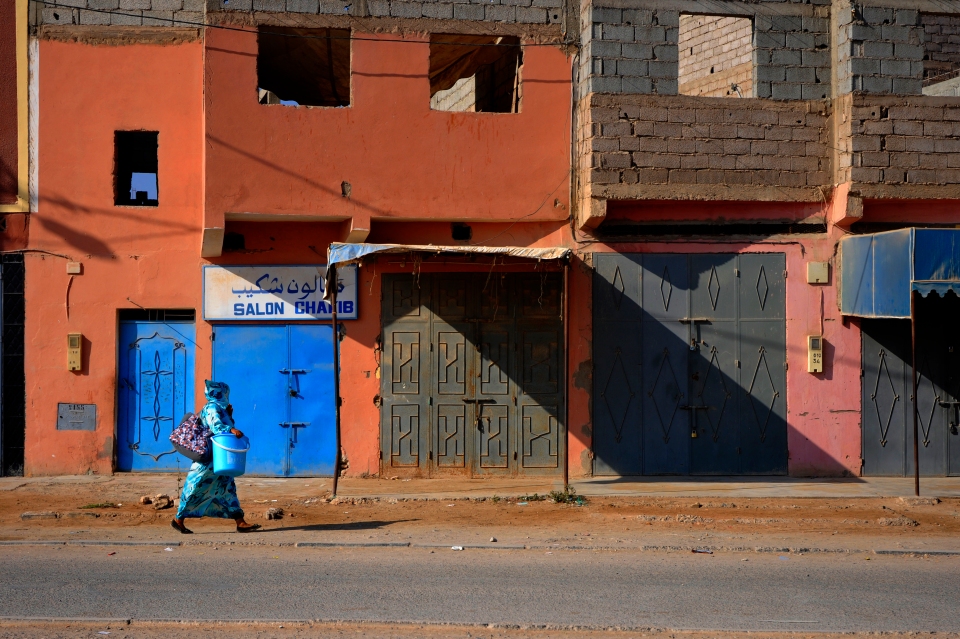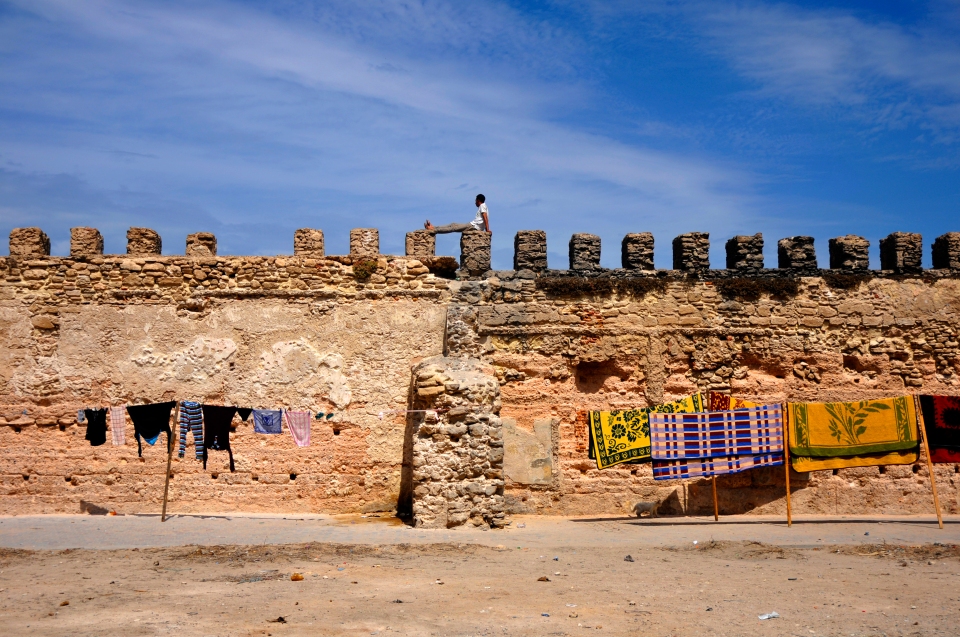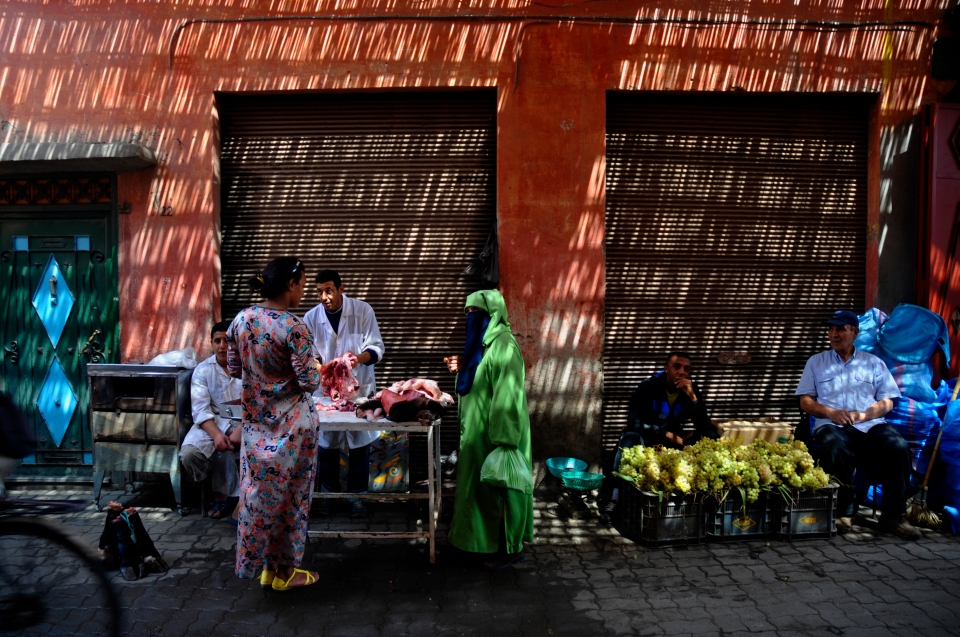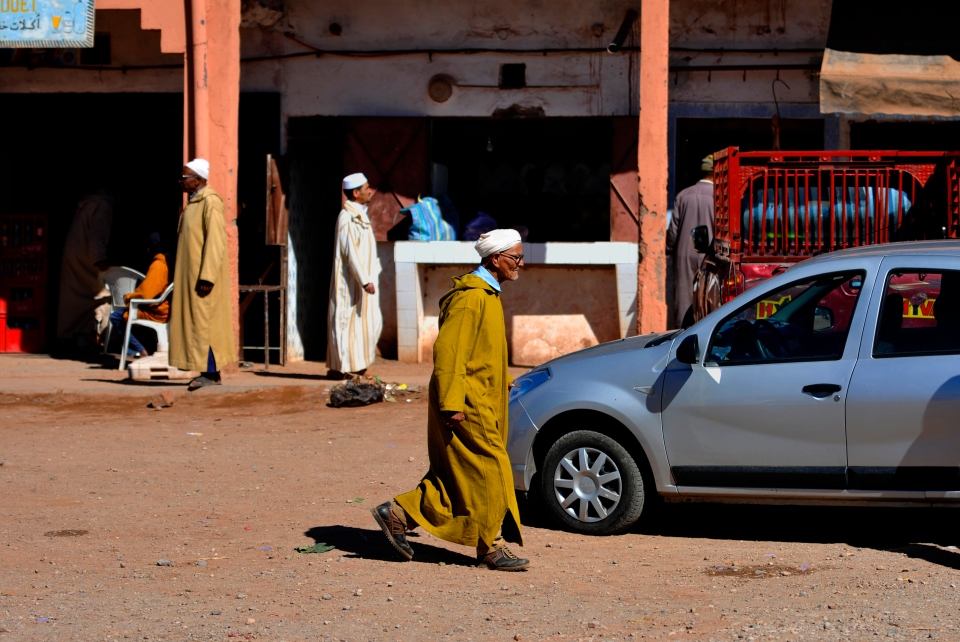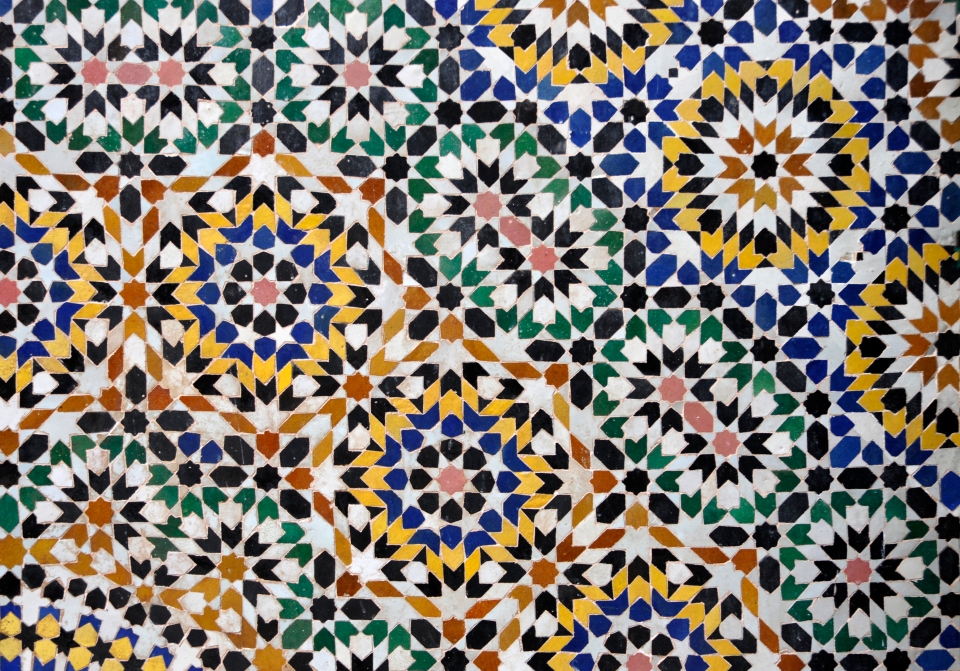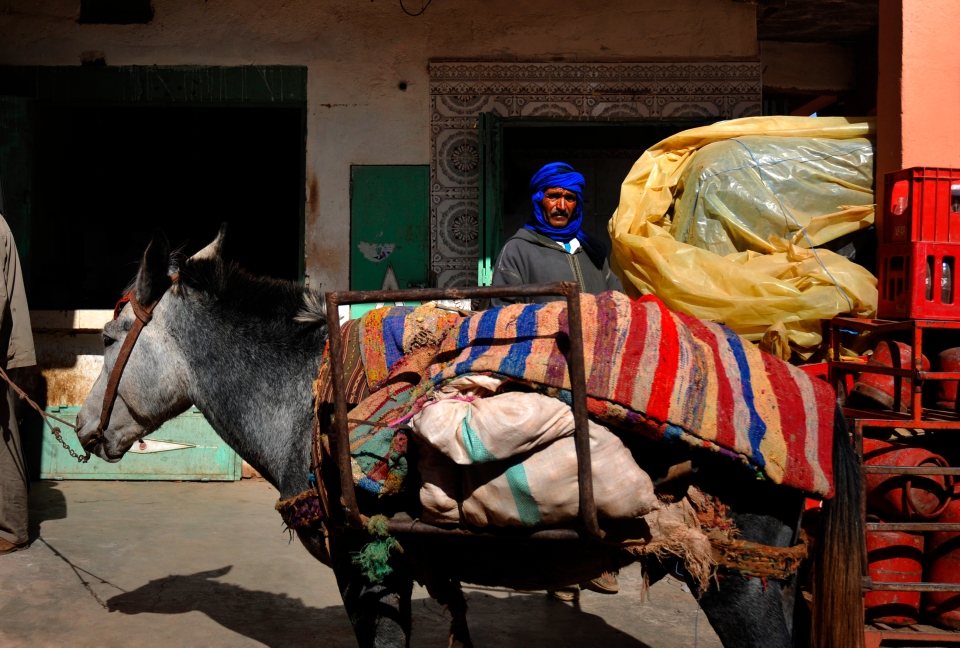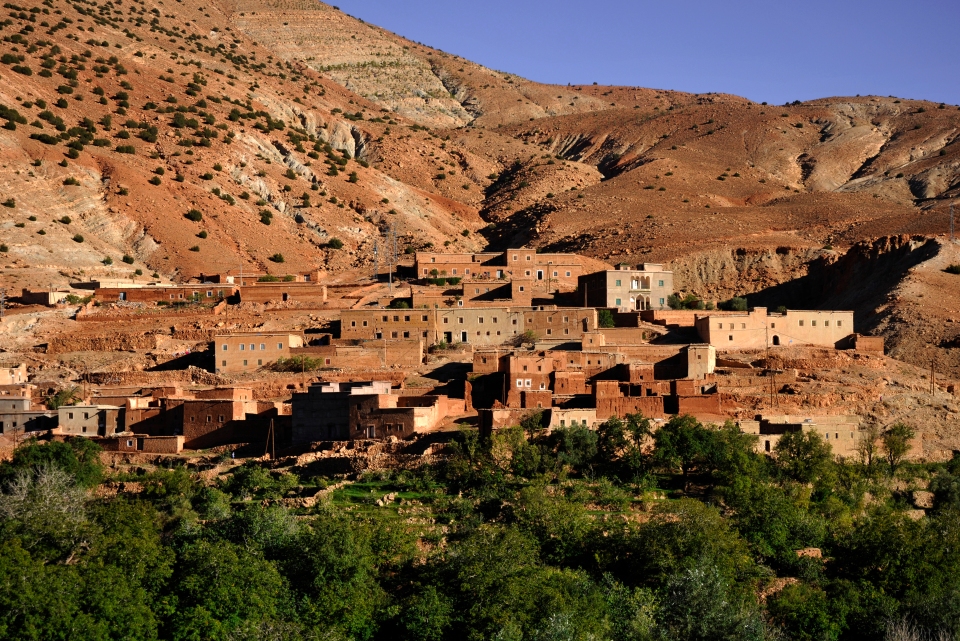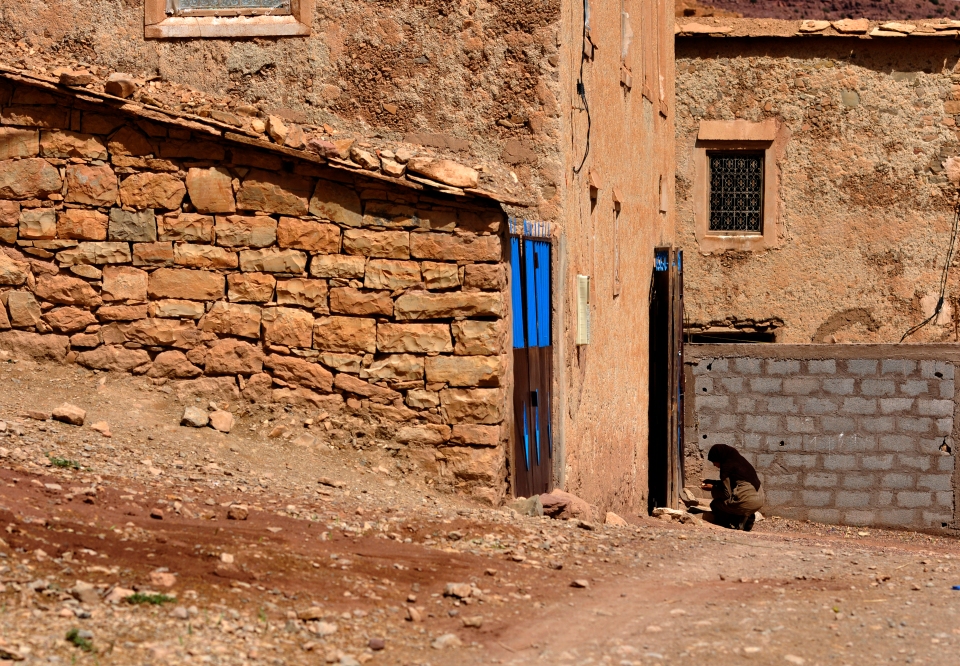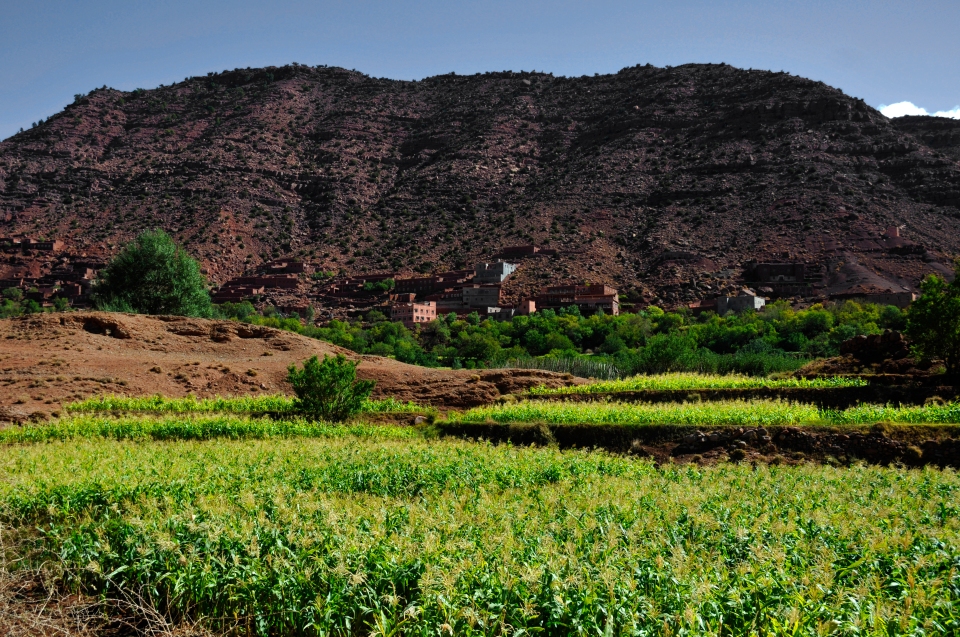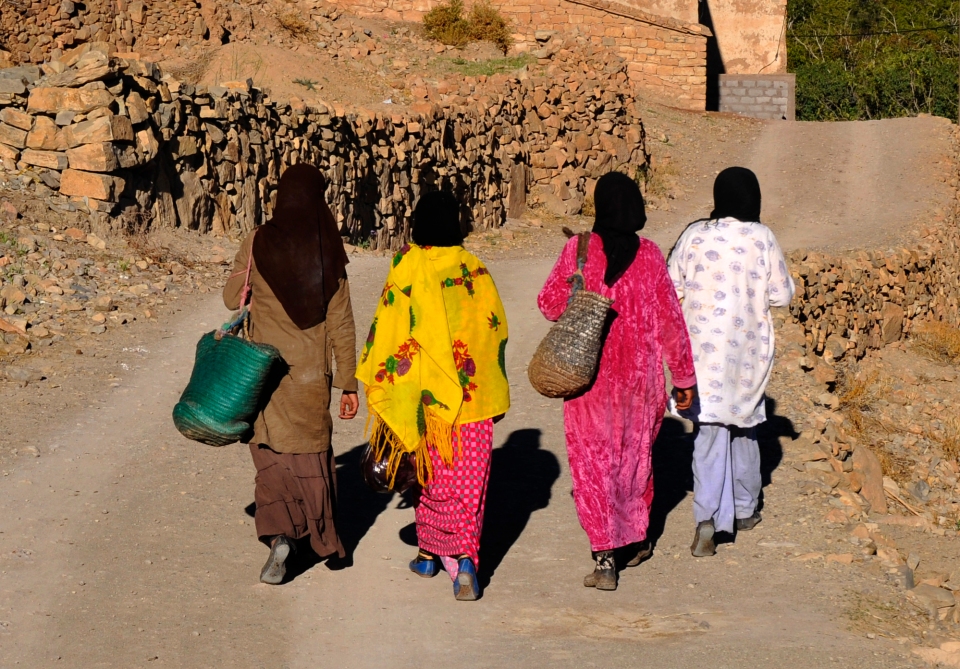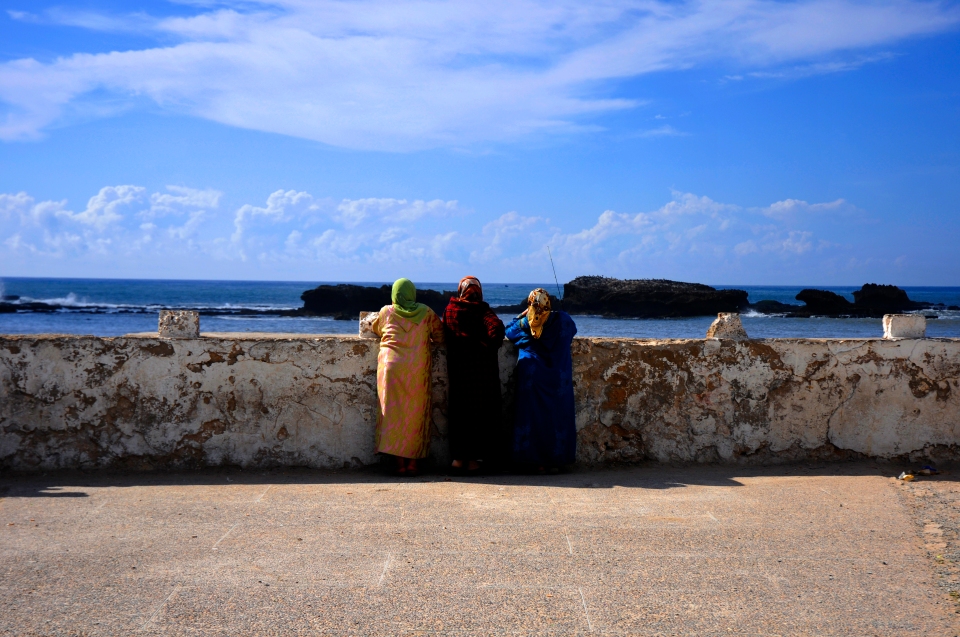| September 21, 2013 |
Man on the beach, Morocco - Image by Kristian Bertel
A Moroccan man is resting on the beach in Essaouira, Morocco. Bordered by the Mediterranean Sea and the Atlantic Ocean, Morocco has several thousand kilometers of coast whose landscapes are diverse and beaches welcoming. The most visited beaches are naturally located not far from cities, especially on the Atlantic coast. But there are hundreds of others in places where nature has remained unspoilt.
Woodcarving shop, Morocco - Image by Kristian Bertel
Essaouira is well known for its woodwork and you can visit a string of shops near the Skala de la Ville. The exquisite marquetry work on sale is made from local fragrant thuya wood, which is now an endangered species.
Valley in Morocco - Image by Kristian Bertel
On the road from Telouet to Marrakech in Morocco there are spectacular views on all these beautiful mountains around. You can see white summits, colorful mountains in green and red, deep gorges, and traditional berber villages on your way.
Sunset in Morocco - Image by Kristian Bertel
A sunset in Essaouira, Morocco. Essaouira lies on the Atlantic coast west of Morocco and is one of the most picturesque towns in the country. An easy weekend escape from Marrakech, Essaouira is a must for a truly memorable Moroccan experience.
Shopping street, Morocco - Image by Kristian Bertel
A Moroccan street vendor is sitting outside his small shop in Marrakech, Morocco.
Marrakech, Morocco - Image by Kristian Bertel
Marrakech, is a magical city that continues to unfold with mystery and ambience. You never know what is really hidden behind the closed doors. But in the streets you can feel the many personalities that make up this fascinating city.
Woman in orange, Morocco - Image by Kristian Bertel
A Moroccan woman is wearing orange clothing in Essaouira, Morocco. The Medina of Essaouira, formerly named Mogador, is an outstanding example of a fortified town of the mid-eighteenth century.
Woman in turquoise, Morocco - Image by Kristian Bertel
A Moroccan woman is wearing a turquoise djellaba in Marrakech, Morocco.
Cliffside, Morocco - Image by Kristian Bertel
Clothing is set to dry on the cliffside in the high Atlas Mountains in Morocco. With its mountain ranges, narrow roads and mud-brick village houses this environment creates an amazing encounter with nature and its challenging terrain.
Passageway, Morocco - Image by Kristian Bertel
A Moroccan woman is walking in a passageway in Marrakech, Morocco.
Shipyard, Morocco - Image by Kristian Bertel
Moroccan men are working on a shipyard in Essaouira, Morocco. A shipyard is a place where ships are repaired and built and is constructed nearby the sea to allow easy access for their ships.
Woman in a village, Morocco - Image by Kristian Bertel
A Moroccan woman is walking by a couple of red doors in Morocco. Morocco with its warm colors. Together with the beauty of the old cities, and the friendly looking faces of the people and the intriguing natural sites.
Skala du Port in Essaouira, Morocco - Image by Kristian Bertel
Skala means sea bastion and two were built in Essaouira to protect the town, the Skala du Port in the south and the Skala de la Ville in the northwest. A must do in Essaouira is to wander around the fishing port. Here you will see the locals bringing in their catch, nets, birds flying around, fresh fish smells and a hive of activity selling fresh fish.
Woman in Morocco - Image by Kristian Bertel
A traditional dressed Moroccan woman is walking in a narrow street in Essaouira, Morocco. Most of the cities in Morocco have preserved at least portions of their medieval medinas. The streets in these areas are very narrow, and they are, for practical reasons, substantially carfree, although not always motorcycle-free.
Olive-seller, Morocco - Image by Kristian Bertel
An olive-seller in Essaouira, Morocco. Tables of olives are often packed so tightly in neat tapering piles as in the souks of Morocco, a country where olives are widely used as appetizers and served with herbs, such as thyme, rosemary and oregano. An important player in the world’s olive market, Morocco is the second largest producer of table olives and the sixth of olive oil.
Cycling in Marrakech, Morocco - Image by Kristian Bertel
A cycling man in Marrakech, Morocco. Marrakech is a wonderful combination of delightful aromas, bright colourful marketplaces and the contrasting arid desert. Sometimes called ‘Morocco City’, this vibrant destination has long been known as the meeting place of southern tribesmen and Berber villagers.
Sandpaper shop, Morocco - Image by Kristian Bertel
A Moroccan man is walking by a sandpaper shop in Essaouira, Morocco. Wherever you go in Morocco, you may also find all kind of handicrafts, generally without any mention of its origin and quality. Door to door, in the narrow streets of the Medina, in the shades of the walls, comparing styles, shapes, prices, and smiles, you feel the real Morocco.
Woman in red, Morocco - Image by Kristian Bertel
A Moroccan woman is wearing a red djellaba in Marrakech, Morocco. Marrakech has had a long and colorful history since its founding by the Berber Almoravids in 1062. It was the capital of an Islamic empire that reached from central Spain to West Africa and called the ‘Pink City’ because of the color of the local earth used in its construction.
Silhouettes in Essaouira, Morocco - Image by Kristian Bertel
Silouettes of people walking by in Essaouira, Morocco. Essaouira’s craftsmen are renowned for their woodwork and lacquerware. Intricately inlaid boxes, chessboards and curios can be found for good prices in the city’s hundreds of shops; however, beware that extensive deforestation is taking place in the area due to these woods not being replanted. Artwork of all kinds can be had here.
Boy at the beach, Morocco - Image by Kristian Bertel
The beach dominates the Essaouirans’ leisure time. Although the strong wind and currents makes relaxed tanning and swimming a little difficult at times, it is perfect for kitesurfing and windsurfing. With good winds for most days of the year, Essaouira is a watersports’ paradise.
Koutoubia Mosque, Morocco - Image by Kristian Bertel
The Koutoubia Mosque is the largest mosque in Marrakech, Morocco. It is located in the southwest medina quarter of Marrakech. The mosque is ornamented with curved windows, a band of ceramic inlay, pointed merlons, and decorative arches. It has a large plaza with gardens, and is floodlit at night.
Man in orange, Morocco - Image by Kristian Bertel
A Moroccan man is wearing an orange djellaba in Essaouira, Morocco. Essaouira is a city in the western Moroccan economic region of Marrakech-Tensift-Al Haouz, on the Atlantic coast. Since the 16th century, the city has also been known by its Portuguese name of Mogador or Mogadore.
Alley in Morocco - Image by Kristian Bertel
A Moroccan woman is wearing a purple djellaba in Marrakech, Morocco. The city is divided into two distinct parts: the Medina, the historical city, and the new European modern district called Gueliz or Ville Nouvelle. The Medina is full of intertwining narrow passageways, alleys and local shops full of character. In contrast, Gueliz plays host to modern restaurants, fast food chains and big brand stores.
Boy in Morocco - Image by Kristian Bertel
A Moroccan boy is walking on rocks near the ocean in Essaouira, Morocco. Essaouira’s medina is walled like many old towns in Morocco and the ramparts are quite impressive as they’re built on the cliffs. Locals and visitors alike enjoy strolling along the ramparts as the sun sets.
Man in white, Morocco - Image by Kristian Bertel
A Moroccan man is wearing a white djellaba in Marrakech, Morocco.
Morocco - Image by Kristian Bertel
A Moroccan man in Essaouira, Morocco. The walled centre of town, the Medina, is supposedly restricted to non-motorized vehicles, but this rule is widely ignored in the case of mopeds which are an increasing nuisance. Other than that, there are occasional donkey carts to dodge.
Woman in Essaouira, Morocco - Image by Kristian Bertel
A Moroccan woman is walking in a narrow street in Essaouira, Morocco. Essaouira is at once familiar and exotic with its fortified walls, fishing harbour and seagulls soaring and screaming over the town.
Mountain range, Morocco - Image by Kristian Bertel
The High Atlas mountains in Morocco. Visible from both the Mediterranean and the Sahara, Morocco’s mountains are as iconic as medinas and tajines.
Silhouettes, Morocco - Image by Kristian Bertel
People are watching the sun go down in Essaouira, Morocco. The Moroccan coast is an unsung glory. Just as epic as mountains.
Man in Morocco - Image by Kristian Bertel
Portrait of a Moroccan man in Essaouira. Most of Morocco’s population consists of Berbers, Arabs and French expats. The Berbers are the indigenous people of North Africa and live in Morocco, Algeria and Tunisia. The Berbers, who once ruled over kingdoms in the region, were conquered by the Arabs at the beginning of the seventh century.
Garment-seller, Morocco - Image by Kristian Bertel
Morocco offers an amazing variety of scenery, colors and people that pleases every photographer. In this photograph a Moroccan man is selling shawls. Another popular garment in Morocco is the djellaba, which is the classic garment with a long sleeves and loosely fitting hooded. Although traditionally a outer robe. Djellabas come in a variety of styles, patterns and colors, with equally as many different materials. Typically, men traditionally wear a hat, kufi, or a red fez hat, tarboosh, and soft yellow leather slippers, babouche, with a djellaba.
Man on mule, Morocco - Image by Kristian Bertel
A Moroccan man is riding on a mule in the beautiful Tighza Valley in Morocco.
Farmer in Morocco - Image by Kristian Bertel
A farmer brings home today’s harvest in the Tighza Valley in Morocco. Despite icy winters and scalding summers, the High Atlas Mountains are extremely fertile. Overgrazing, agriculture and wood collection for fuel has impacted the High Atlas, so much of its indigenous vegetation has disappeared. But through painstaking reforestation and resourceful mountainside terrace farming, the hills are alive with a diversity of flora.
Landscape, Morocco - Image by Kristian Bertel
A tree is framed by stunning surroundings in the Tighza Valley, where terraces scale High Atlas valleys walls to surprising heights.
Ave Zerktouni, Morocco - Image by Kristian Bertel
Avenue Zerktouni is one of the main streets of Essaouira in Morocco. Most of the old city and fortifications in Essaouira today date from the 18th century, but the town has a much older history that started with the Phoenicians. For centuries, foreigners had a grib over the town, and although Moroccans eventually reclaimed it, the foreign influence lingers on in the way the town looks and feels today.
Man in the street, Morocco - Image by Kristian Bertel
A Moroccan man in the street. To acknowledge or graciously refuse a kind gesture, all you need to know is one phrase: Barakllafik, literally ‘blessings with you’. More than a pleasantry, this is considered a potent blessing, especially when uttered with one hand on he heart and looking directly in the eye of the intended recipient.
Fishing boats in Essaouira, Morocco - Image by Kristian Bertel
A pattern of blue fishing boats is framing the harbour of Essaouira, Morocco. Essaouira has a beautiful fishing port with a Portuguese fort. This seaside town has a relaxed atmosphere and very little hassle. The blue local fishing boats are eye catching and the fishermen can be seen bringing fresh fish and sea creatures.
Woman in the street, Morocco - Image by Kristian Bertel
A Moroccan woman is walking in a street in Essaouira, Morocco. Although there aren’t so many formal sights in Essaouira, it’s a wonderful place to visit. For the visitor, the mellow atmosphere, narrow winding streets lined with colorful shops, whitewashed houses and heavy old wooden doors make it a wonderful place to stroll.
Camels at the beach, Morocco - Image by Kristian Bertel
Camels in Essaouira in Morocco. It is the wind, the beautifully named alizee, or taros in Berber, that, despite the crowds, ensures Essaouira retains its character and the town has been dubbed as the ‘Wind City of Africa’.
Man walking by the door, Morocco - Image by Kristian Bertel
A Moroccan man is walking by the door in an alley in Essaouira, Morocco. Essaouira lies on the crossroads between two tribes: the Arab Chiadma to the north and the Haha Berbers in the south. Add to that the Gnawa, who came originally from further south in Africa, and the Europeans and you get a rich and diverse cultural mix.
Men in Marrakech, Morocco - Image by Kristian Bertel
Street scene from Marrakech, Morocco. Urban Marrakech may surprise you with small-town social graces. Offers of mint tea, assistance for the elderly, treats for children and invitations to share meals are common courtesies in Marrakech.
Djemaa el-Fna in Marrakech, Morocco - Image by Kristian Bertel
Everywhere you look in Djemaa el-Fna, Marrakech’s main square and open-air theatre, you will discover drama already in progress. When the shadows fall in the evening, 100 chefs arrive with grills in tow and cueing musicians tune up their instruments.
Man in Marrakech, Morocco - Image by Kristian Bertel
A Moroccan man at the door in Marrakech, Morocco.
Man on bike, Morocco - Image by Kristian Bertel
A Moroccan man on a bike at the harbour in Essaouira, Morocco. The large working port is a bustling place with plenty of activity throughout the day. Along with the flurry of boats, nets being repaired and the day’s catch being landed you can see traditional wooden boats being made.
Mountains in Morocco - Image by Kristian Bertel
A colorful palette of colors makes the mountains of Morocco very beautiful.
Woman in shop, Morocco - Image by Kristian Bertel
A Moroccan woman is framed by traditional Moroccan straw bags in a shop in Essaouira in Morocco.
Majestic mountains, Morocco - Image by Kristian Bertel
A Moroccan man is standing on a roof in a majestic scene of mountains in the Tighza Valley, Morocco.
Village in the mountains, Morocco - Image by Kristian Bertel
A small village placed on a mountain. Many people picture Morocco as one big oasis surrounded by sand, so the geographical variety comes as a surprise.
Water men in Marrakech, Morocco - Image by Kristian Bertel
The traditional water men or water-sellers of Morocco are seen on the main square in Marrakech, the chaotic circus of charlatans and showmen at the dusty heart of Marrakech.
Mountain road, Morocco - Image by Kristian Bertel
A windin mountain road in the Tighza Valley of Morocco.
Man in Essaouira, Morocco - Image by Kristian Bertel
An elderly Moroccan man is walking in one of the main streets of Essaouira in Morocco. Most Moroccans are of mixed Arab-Berber, Arab, Berber and Niger-Congo ethnic background. Arabs and Berbers make up about 99.1% of the Moroccan population. Berbers are the indigenous people and still make up the bulk of the population.
Hat-seller, Morocco - Image by Kristian Bertel
A Moroccan hat-seller in Essaouira, Morocco. Anything that isn’t nailed down in Morocco is likely to be woven, sewn or embroidered. Moroccan stitchery ranges from simple Berber designs to minutely detailed terz Fezzi, the elaborate nature-inspired patterns stitched in blue upon white linen.
Tighza Valley, Morocco - Image by Kristian Bertel
A small village almost blends in with the surrounding mountains in Tighza Valley, Morocco.
Man in corridor, Morocco - Image by Kristian Bertel
A silhouette of a man is seen in a corridor in Essaouira, Morocco.
Straw bag-seller, Morocco - Image by Kristian Bertel
A Moroccan straw bag-seller in Essaouira, Morocco. These functional and ecological Moroccan straw bags are made of real palm leaf and water reed.
Shawl-seller, Morocco - Image by Kristian Bertel
A Moroccan shawl-seller in Essaouira, Morocco.
Rahba Kedima in Marrakech, Morocco - Image by Kristian Bertel
Famous for its colorful buildings and market stalls, Rahba Kedima offers tourists a genuine taste of Morocco. This small square or rather triangle is an attractive, colourful and therefore photogenic patch of ground situated just a short walk north east of the Djemaa el-Fna.
Woman in Marrakech, Morocco - Image by Kristian Bertel
A Moroccan woman at Djeema el-Fna in Marrakech, Morocco. There’s nowhere on Earth like the Djemaa el-Fna, the square at the heart of old Marrakech. The focus of the promenade for locals, the Djemaa is a heady blend of henna painters, snake charmers and food bazaars. As the sun travels across the sky, orange-juice vendors make way for healers and henna tattoo artists, who scoot over for snake charmers, astrologers and acrobats.
Street in Marrakech, Morocco - Image by Kristian Bertel
A Moroccan man dressed in orange is cycling through a small street in Marrakech, Morocco. Marrakech is a magical city that continues to unfold with mystery and ambience. Even someone with the keenest sense of direction is guaranteed to get lost in the twisting, turning, unmarked streets of Marrakech.
Beach vendors, Morocco - Image by Kristian Bertel
A couple of beach vendors are sitting on the pavement near the beach in Essaouira, Morocco.
Woman and car, Morocco - Image by Kristian Bertel
An elderly woman talks to a taxi driver in Marrakech, Morocco. If you are catching taxis in Marrakech, make sure to get a reasonable price, and agree on the fare before you get in. If a taxi driver sees you are a tourist, they will try to charge you more than double what the fare really should be.
Food-sellers in Marrakech, Morocco - Image by Kristian Bertel
Marrakech is home to some of the best, most authentic shopping options. Though it is often referred to as the Marrakech Souk by the uninitiated, there is actually no central market area, rather a series of interconnected markets that specialize in different items.
Man in the field, Morocco - Image by Kristian Bertel
A Moroccan man is surrounded by green colors while picking berries in the Tighza Valley in Morocco.
Man in the valley, Morocco - Image by Kristian Bertel
An elderly Moroccan man is loading hay on a mule in the Tighza Valley in Morocco. This hard working animal called the mule is found through out Africa. Used as a lorry and taxi, he can carry up to 100 kg over the hardest of conditions. In the winters the mule will be used in the snow, the freezing temperatures of the High Atlas Mountains being all part of a days work.
Women in Marrakech, Morocco - Image by Kristian Bertel
Three women in Marrakech, Morocco. Moroccans are extremely hospitable and very tolerant. Though most people are religious, they are generally easy-going, and most young Moroccan women don’t wear a veil, though they may well wear a headscarf.
Man with handcart, Morocco - Image by Kristian Bertel
A Moroccan man is pulling his handcart in Essaouira, Morocco. With bustling souqs and spice markets, stunning mosques, white-washed sea side towns and medieval city centres, no-one ever has to be bored in this beautiful country.
Woman with bucket, Morocco - Image by Kristian Bertel
A Moroccan woman is walking in a small village on the road between Marrakech and Essaouira in Morocco. At just a few hours from the main European cities, Morocco has everything to overwhelm you with the amazing colors, smells and sounds of Islamic Africa.
Young man, Morocco - Image by Kristian Bertel
A young Moroccan man enjoys the ocean view on top of the city wall in Essaouira, Morocco.
Souk in Marrakech, Morocco - Image by Kristian Bertel
Sunbeams light through a souk in Marrakech, Morocco. A souk was originally an open-air marketplace. Historically, souks were held outside cities at locations where incoming caravans would stop and merchants would display their goods for sale. Souks took place whenever a caravan or caravans had arrived. Souks might have a social function, in terms of being a place to meet, in addition to its commercial function. Later, due to the importance of the marketplace and the growth of cities, the locations of souks shifted to urban centers.
Man walking in Telouet, Morocco - Image by Kristian Bertel
A Moroccan man is walking outside the weekly market in the small village of Telouet in Morocco. Telouet is an interesting town, surrounded by fields and the backdrop of mountains of the High Atlas range. Telouet is around 100 km drive from Marrakech and is sited at 1,800 m on the old caravan route towards Ouzarzate and the Sahara beyond.
Zellij tilework, Morocco - Image by Kristian Bertel
Zellij tilework inside the Kasbah of el Glaoui in Telouet, Morocco. The Kasbah of el Glaoui is a stunning, crumbling kasbah with a beautiful mountainous backdrop, one of the most spectacular in the Atlas mountains, although now it is in various states of decay. It was started by the Glaoui family, who had risen to power of Morocco south of the High Atlas in the late 1800s, and who worked with the French in the early 1900s. However, it was never completed. Inside visitors can wander through the large state rooms, with dusty pink plaster and painted cedar ceilings, and colorful zellij tilework.
Man in Telouet, Morocco - Image by Kristian Bertel
A Moroccan man is drapped in a blue head scarf at the weekly market in Telouet, Morocco. Colorful Berber souks play an important role in Moroccan village life and, each week in Telouet, there is a traditional market where you can wander amongst the local community as they shop for meat on the hoof, dates, spices, fresh vegetables and all manner of household goods.
Berber village, Morocco - Image by Kristian Bertel
The High Atlas is a region in Morocco covering the mountain range and surrounding destinations such as Marrakech. It’s a regular destination for mountain hikers, ski enthusiasts, or travelers interested in the indigenous Berber culture found throughout its many peaks and valleys.
Girl in Morocco - Image by Kristian Bertel
A Moroccan girl crouches in the High Atlas Mountains, where villages, stunning mountain views and traditional Berber communities have reigned for centuries. The High Atlas Mountains are home to relatively pure Berber populations, who live in earthen houses.
Green field in Morocco - Image by Kristian Bertel
Moroccan agricultural production consists of orange, tomatoes, potatoes, olives, and olive oil. High quality agricultural products are usually exported to Europe.
Women in the mountains, Morocco - Image by Kristian Bertel
Four Moroccan women are walking on a road in the mountains of Morocco. Whether it is the colors of the walls surrounding the Medina in Marrakech, or the lively clothing of the people, or the many local crafts they had for sale, colors were a dominant theme in everything you can see. This is not a country of subdued dress or earth tones. Every marketplace was jammed with colorful spices, fish, meat, vegetables, and people.
Man in the hall, Morocco - Image by Kristian Bertel
A Moroccan man is walking in a hall in Marrakech, Morocco.
Women in Essaouira, Morocco - Image by Kristian Bertel
Moroccan women are looking at the sea in Essaouira, Morocco. Essaouira is a laid back coastal town that offers travelers a nice break from the hubbub of Marrakech which is just a few hours away. Visitors to Essaouira are attracted to its beaches, fresh seafood and medina.
 Kristian Bertel, Photographer Kristian Bertel, Photographer |
